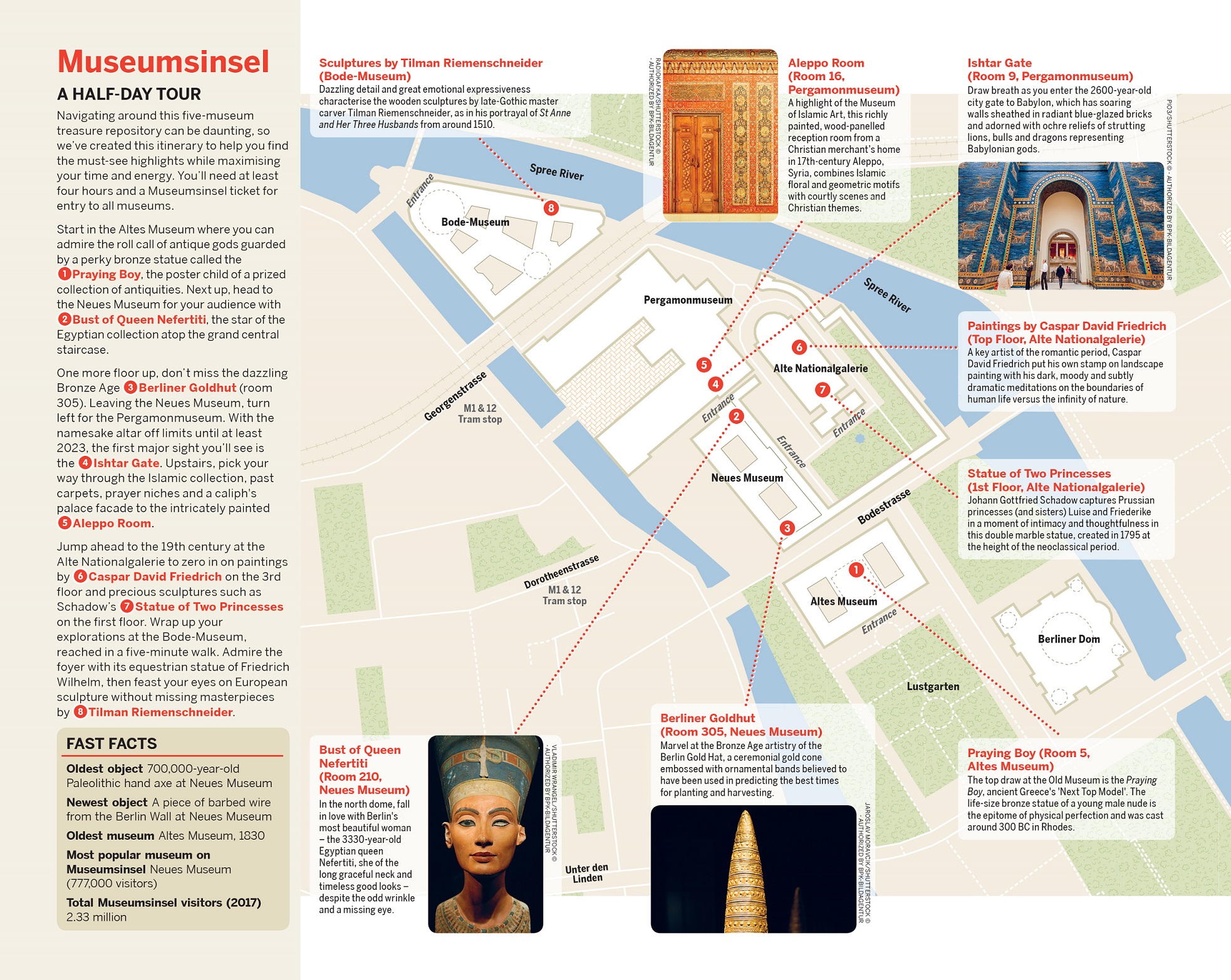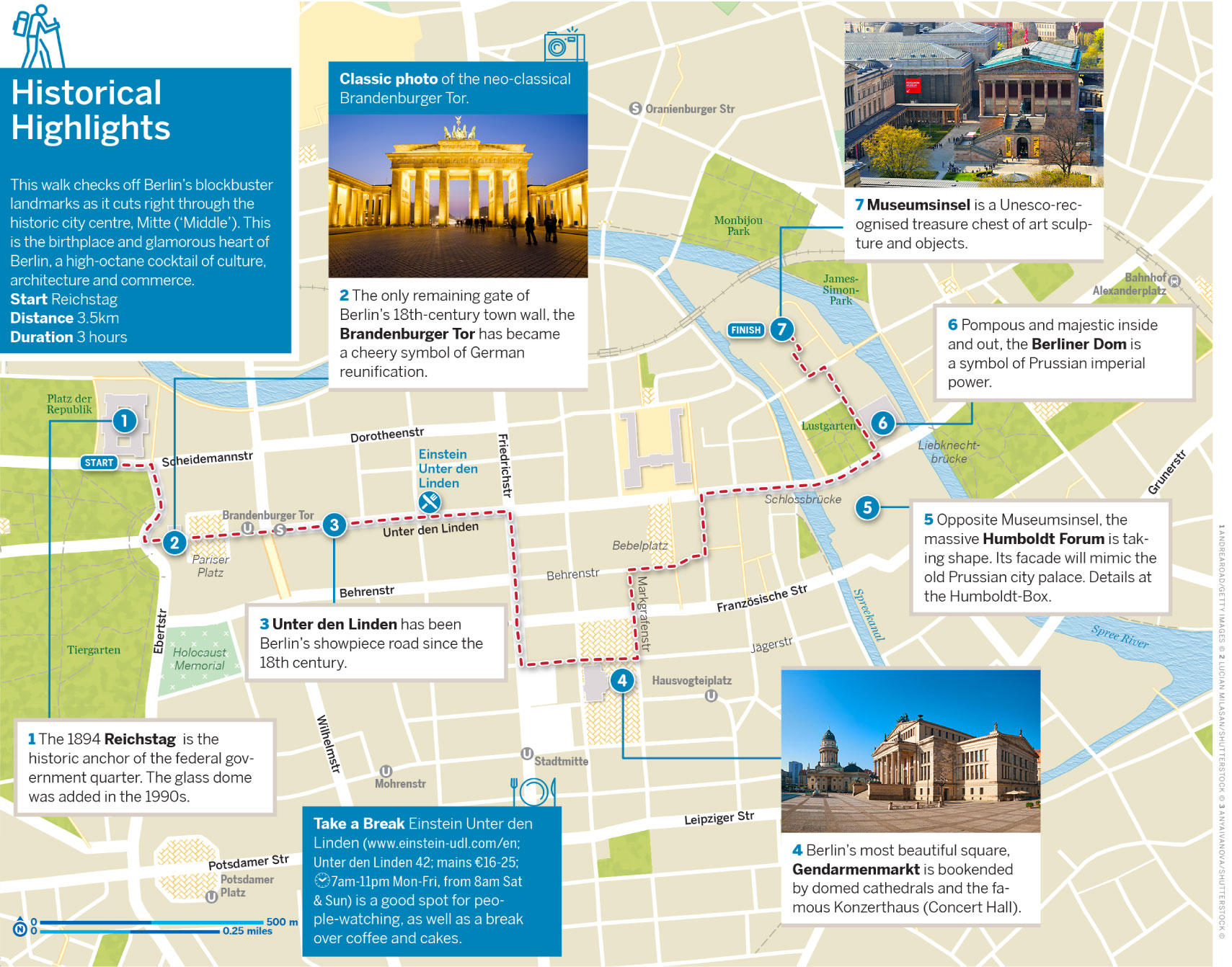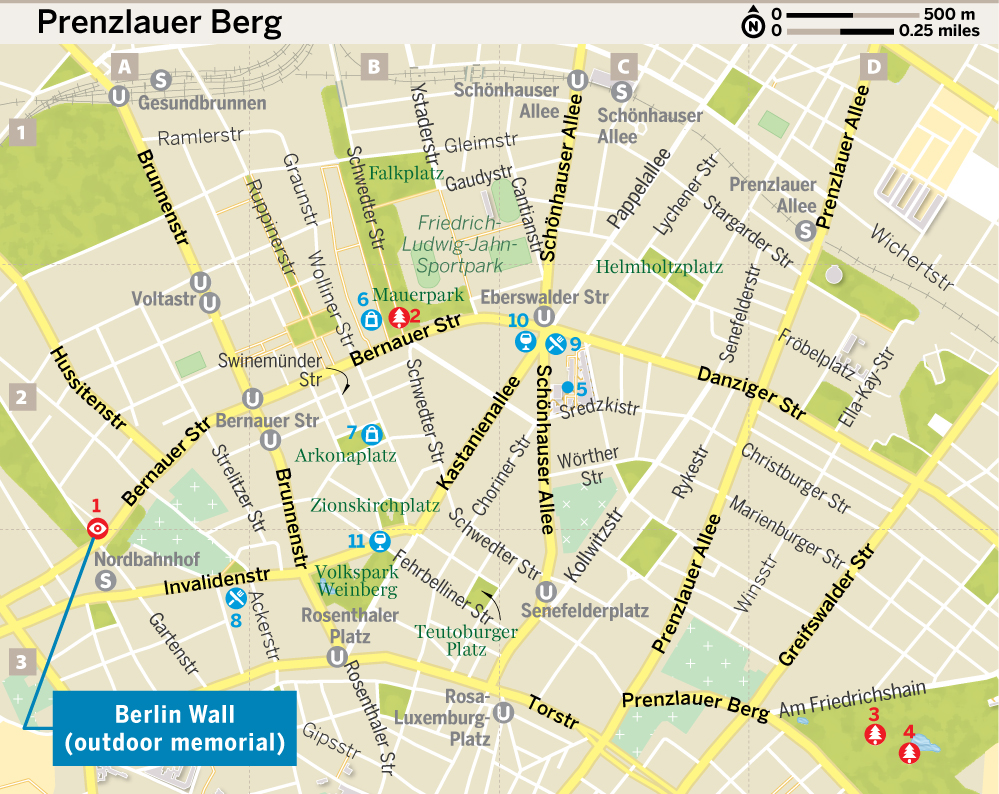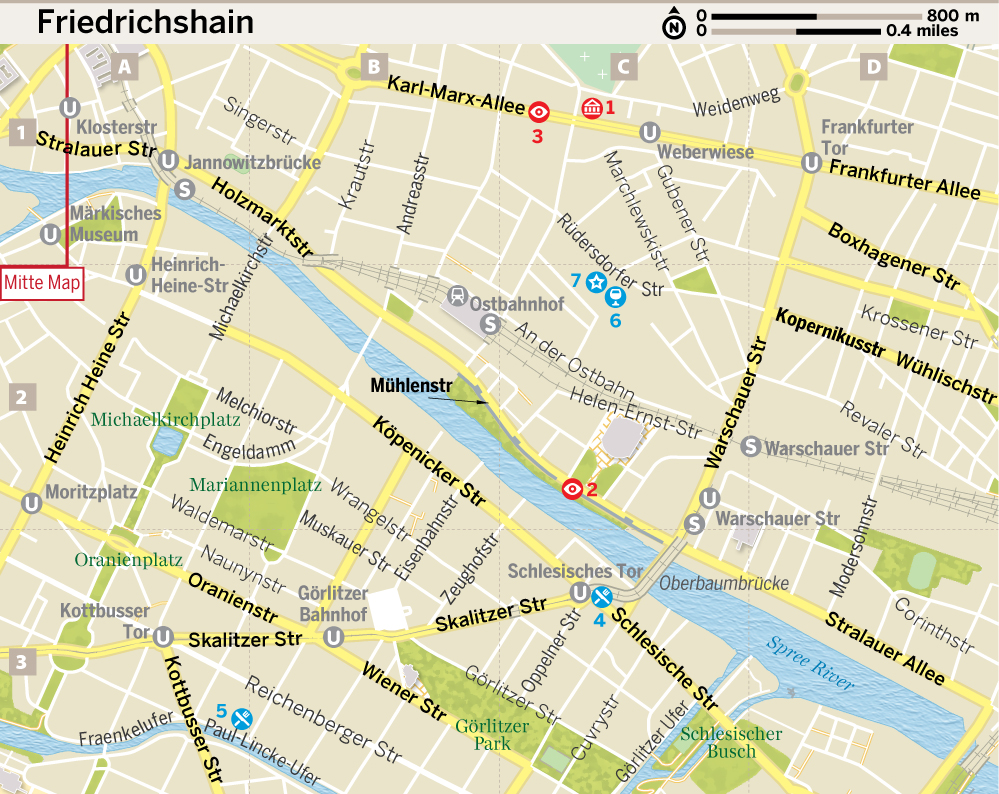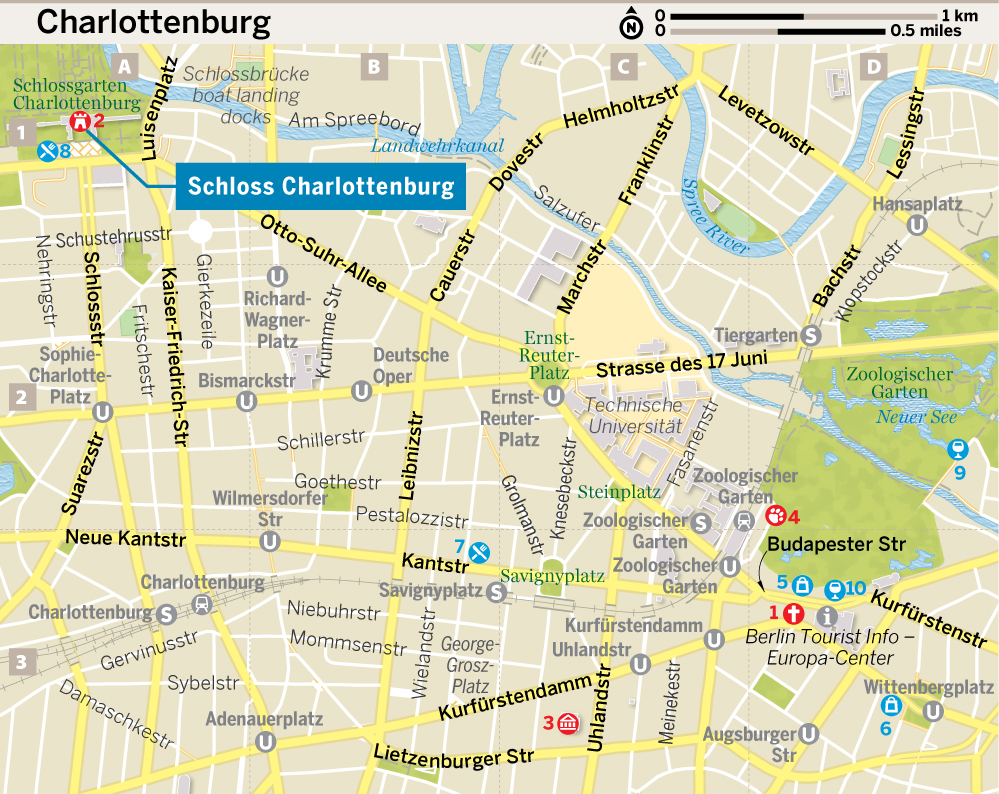Berlin
Reichstag
Brandenburger Tor
The Berlin Wall
Museumsinsel
Schloss Charlottenburg
Holocaust Memorial
Berlin Nightlife
Sights
Activities
Tours
Shopping
Eating
Drinking & Nightlife
Entertainment
Berlin at a Glance…
In the past century alone, Berlin staged a revolution, was bombed to bits, torn in two then ultimately reunited. History aside, Berliners (understandably) love a good time. Ways to entertain yourself here are endless – from bars to techno temples, beer gardens, cocktail caverns, cabaret shows and symphonies! A hotbed of creativity, Berlin’s post-Wall abundance of spaces and its irrepressible, free-wheeling spirit give rise to a culture that thrives on experimentation and new ideas. High-brow, low-brow and everything in between – the full arc of expression is welcomed here.
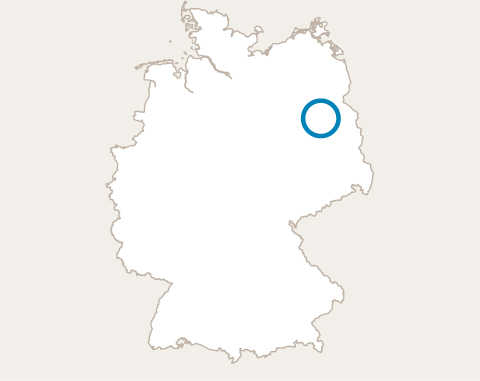
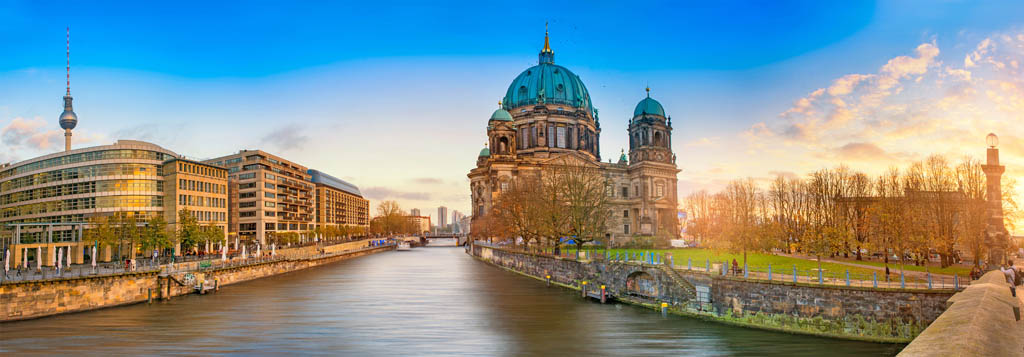
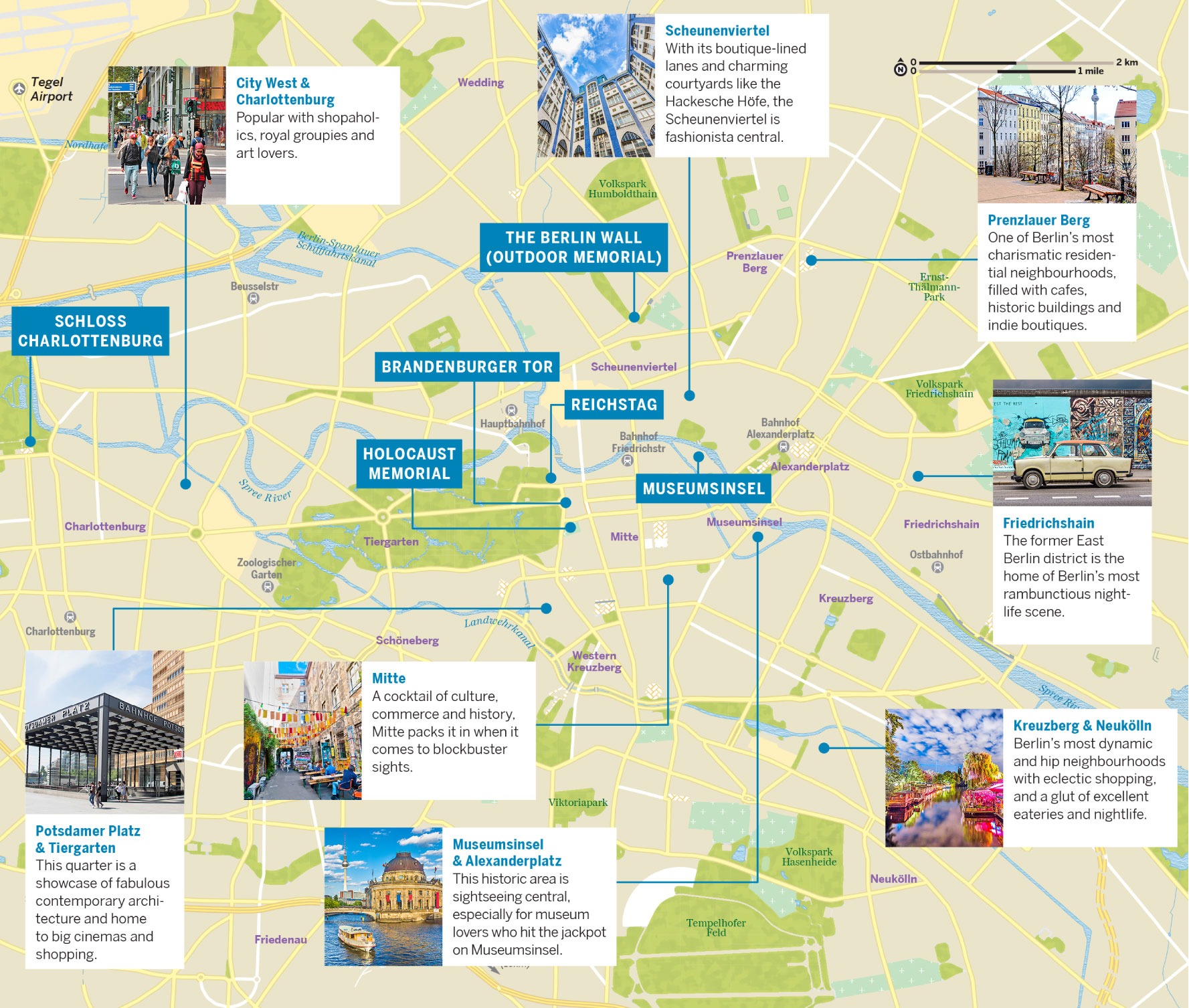
Berlin in Two Days
Kick off day one at the Reichstag then stroll south to the Brandenburg Gate, Berlin’s most recognisable structure. Further south lies the famous Holocaust Memorial and Potsdamer Platz, the city’s heart. Checkpoint Charlie is a short distance away. You could spend the entire second day at the Museumsinsel taking in world-class repositories of the past such as the Pergamonmuseum, Neues Museum and the Bode-Museum.
Berlin in Four Days
Start day three at the Gedenkstätte Berliner Mauer and the Mauerpark. Take a whirlwind tour of Schloss Charlottenburg before heading to the Kurfürstendamm for a spot of shopping. Day four might begin at the Jewish Museum before heading to the East Side Gallery, the longest piece of the Wall to have survived.
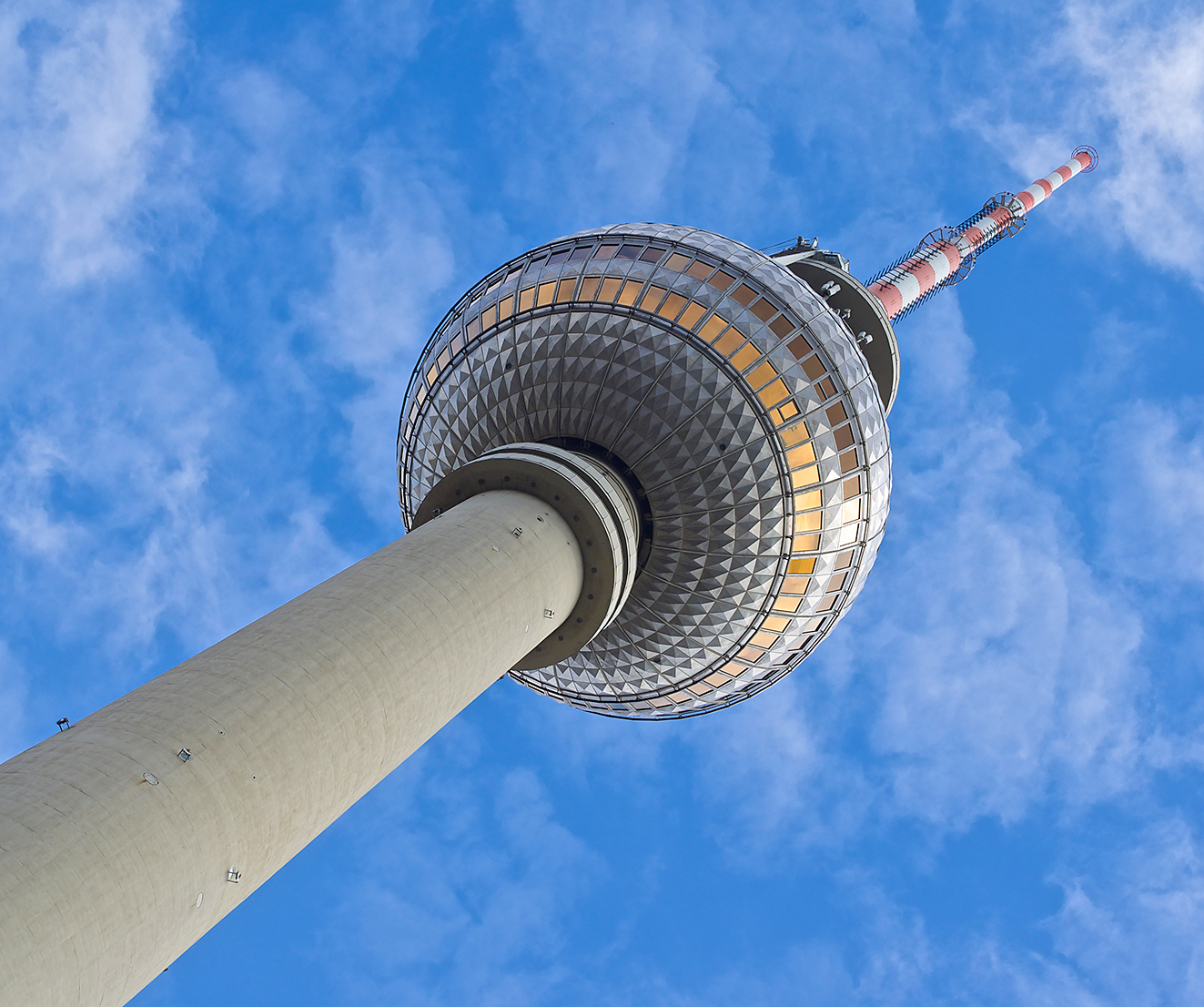
Arriving in Berlin
Tegel Airport TXL express bus to Alexanderplatz (40 minutes) and bus X9 for City West €2.60; taxi €20 to €25.
Schönefeld Airport Airport-Express trains to central Berlin twice hourly (20 to 30 minutes) and S9 train every 20 minutes for Friedrichshain and Prenzlauer Berg €3.20; taxi €40.
Hauptbahnhof Main train station served by S-Bahn, U-Bahn, tram, bus and taxi.
Zentraler Omnibus Bahnhof (ZOB) The central bus station is on the western city edge. U-Bahn U2 to city centre €2.60; taxi €18.
Sleeping
Outside of high season, around holi-days and during major trade shows it’s generally not necessary to book accommodation in advance.
For more information on the best neighbourhood to stay in, see here.
TOP EXPERIENCE
Reichstag
Reinstated as the home of the German parliament in 1999, the late 19th-century Reichstag is one of Berlin’s most iconic buildings.
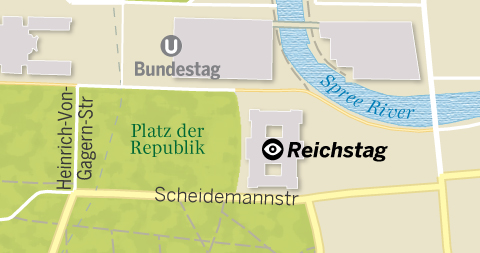
Great For…
 yDon’t Miss
yDon’t Miss
Free auto-activated audioguides provide info on the building, landmarks and the workings of parliament.
 8Need to Know
8Need to Know
map Google map; www.bundestag.de; Platz der Republik 1, Visitors Centre, Scheidemannstrasse; ![]() hlift 8am-midnight, last entry 9.45pm, Visitors Centre 8am-8pm Apr-Oct, to 6pm Nov-Mar;
hlift 8am-midnight, last entry 9.45pm, Visitors Centre 8am-8pm Apr-Oct, to 6pm Nov-Mar; ![]() g100,
g100, ![]() bBrandenburger Tor, Hauptbahnhof,
bBrandenburger Tor, Hauptbahnhof, ![]() b
Brandenburger Tor, Bundestag
b
Brandenburger Tor, Bundestag ![]() F
F
 5Take a Break
5Take a Break
For quick feeds, Berlin Pavillon (map Google map; ![]() %030-2065 4737; www.berlin-pavillon.de; Scheidemannstrasse 1; dishes €4.50-9;
%030-2065 4737; www.berlin-pavillon.de; Scheidemannstrasse 1; dishes €4.50-9; ![]() h8am-9pm) is handy.
h8am-9pm) is handy.
 oTop Tip
oTop Tip
For guaranteed access, make free ticket reservations online before you leave home. All visitors must show ID to enter.
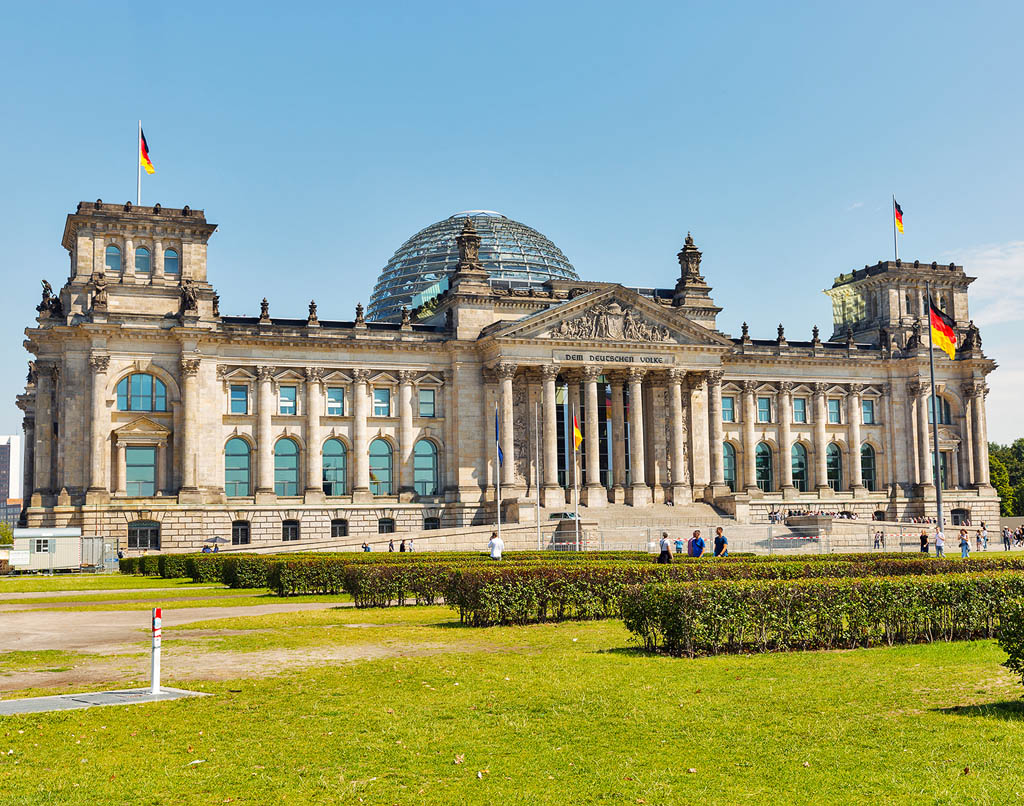
Beginnings
It’s been burned, bombed, rebuilt, buttressed by the Wall, wrapped in plastic and finally brought back from the dead by Norman Foster: ‘turbulent history’ just doesn’t do it when describing what this most famous of Berlin’s landmarks has endured. This neo-baroque edifice was finished in 1894 to house the German Imperial Diet. It served its purpose until 1933 when it was badly damaged by fire in an arson attack carried out by Marinus van der Lubbe, a young Dutch communist. This shocking event conveniently gave Hitler a pretext to tighten his grip on the German state. In 1945 the building was a major target for their Red Army, who raised the red flag in an act that became a symbol of the Soviet defeat of the Nazis.
The Cold War Years
Although in West Berlin, the Reichstag found itself very near the dividing line between East and West Berlin and from the early 1960s, the Berlin Wall. With the West German government sitting safely in faraway Bonn, this grand façade lost its purpose and in the 1950s some in West Berlin thought it should be demolished. However, the wrecking balls never got their day and the Reichstag was restored, albeit without a lot of its earlier decorations.

Reunification & Norman Foster
Almost a year after the Wall came down, the official reunification ceremony was symbolically held at the Reichstag which, it was later decided, would become the seat of the German Bundestag (parliament) once again. Before Norman Foster began his reconstruction work, the entire Reichstag was spectacularly wrapped in plastic sheeting by the Bulgarian-American artist Christo in the summer of 1995. The following four years saw the erection of Foster’s now-famous glittering glass copula, the centrepiece of the visitor experience today. It is the Reichstag’s most distinctive feature, serviced by lift and providing fabulous 360-degree city views and the opportunity to peer down into the parliament chamber. To reach the top, follow the ramp spiralling up around the dome’s mirror-clad central cone. The cupola was a spanking new feature, but Foster’s brief also stipulated that some parts of the building were to be preserved. One example is the Cyrillic graffiti left by Soviet soldiers in 1945.
TOP EXPERIENCE
Brandenburger Tor
A symbol of division during the Cold War, the landmark Brandenburg Gate now epitomises German reunification and often serves as a picturesque backdrop for festivals and concerts.
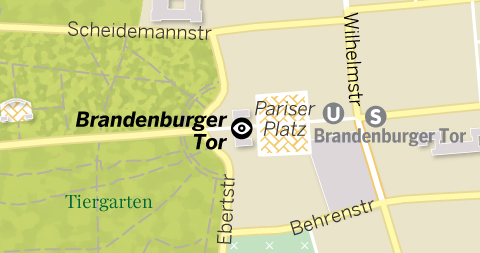
Great For…
 yDon’t Miss
yDon’t Miss
The north wing of the gate houses a quiet room for peaceful contemplation.
 8Need to Know
8Need to Know
Brandenburg Gate; map; Pariser Platz; ![]() bBrandenburger Tor,
bBrandenburger Tor, ![]() b
Brandenburger Tor
b
Brandenburger Tor
 5Take a Break
5Take a Break
There are plenty of cafes along Unter den Linden.
 oTop Tip
oTop Tip
Visit after dark when the gate is lit up in dramatic fashion.

Beginnings
Commissioned by Prussian emperor Fried-rich Wilhelm II (r 1888–1918), architect Carl Gotthard Langhans found inspiration in Athens’ Acropolis for this elegant triumphal arch. It was completed in neo-classical sandstone in 1791 as the royal city gate, and a suitably regal entrance to the grand avenue of Unter den linden (which once led to the palace of the Prussian royals). It is crowned by the Quadriga, Johann Gottfried Schadow’s sculpture of the winged goddess of victory piloting a chariot drawn by four horses. After trouncing the Prussians in 1806, Napoleon famously kidnapped Victory and held her hostage in Paris until she was freed by plucky Prussian general Ernst von Pfuel in 1815.
Cold War Divide
The Brandenburg Gate survived the Red Army’s 1945 onslaught more or less intact, though it stood in an area decimated by shelling. In a rare example of cooperation between East and West Berlin, both sides contributed to a post-war patch up job on the structure. However, from the 1960s it became a symbol of a divided city (and continent) as it was located so close to the Berlin Wall on the western side. In the 1970s and ’80s visitors could climb to the top to peer into the socialist utopia of East Berlin. On 12 June 1987, it was here that Ronald Reagan addressed his most famous Cold War words to the Soviets when he said: ‘Mr Gorbachov – tear down this wall!’.
Two and a half years later, it wasn’t the Russians who took pickaxes to the hated concrete but the East Berliners themselves.
Restoration
In the early years of the new millennium the Brandenburg Gate was restored to its former glory, and reopened in 2002 on the 12th anniversary of German reunification. No longer open to traffic (which had actually caused more damage than WWII) the cobbled area around is usually busy with tourists all day long.
Pariser Platz
The Brandenburg Gate, today a symbol of German unity, stands sentinel over Pariser Platz. This harmoniously proportioned square is once again framed by banks as well as the US, British and French embassies, just as it was during its 19th-century heyday.

TOP EXPERIENCE
The Berlin Wall
For 29 years the Berlin Wall was the most potent symbol of the Cold War. Surprisingly few of its reinforced concrete slabs remain in today’s reunited Berlin (the longest section to survive intact is located at the East Side Gallery).
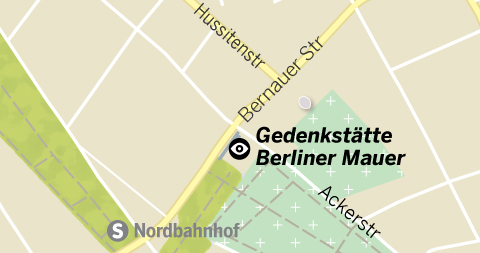
Great For…
 yDon’t Miss
yDon’t Miss
Other hidden pieces of the Wall still stand in Berlin. Ask the tourist offices about locations.
 8Need to Know
8Need to Know
Track down remaining fragments of the Wall across the city using Memorial Landscape Berlin Wall (www.berlin-wall-map.com).
 5Take a Break
5Take a Break
Not far from the outdoor memorial is the famous Konnopke’s Imbiss.
 oTop Tip
oTop Tip
There’s a great view from the Documentation Centre’s viewing platform.
Construction
Shortly after midnight on 13 August 1961, East German soldiers and police began rolling out miles of barbed wire that would soon be replaced with prefab concrete slabs. The wall was a desperate measure taken by the German Democratic Republic (GDR) government to stop the sustained brain and brawn drain it had experienced since its 1949 founding. Around 3.6 million people had already left for the West, putting the GDR on the verge of economic and political collapse.

Demise
The Wall’s demise in 1989 came as unexpectedly as its construction. Once again the GDR was losing its people in droves, this time via Hungary, which had opened its borders with Austria. Something had to give. It did on 9 November 1989 when a GDR spokesperson (mistakenly, it later turned out) announced during a press conference that all travel restrictions to the West would be lifted. When asked when, he said simply, ‘Immediately’. Amid scenes of wild partying, the two Berlins came together again.
Over the course of 1990 the Wall almost disappeared, some bits smashed up and flogged to tourists, other sections carted off to museums, parks, embassies, exhibitions and even private gardens across the globe.
Gedenkstätte Berliner Mauer
The outdoor memorial (map Google map; ![]() %030-467 986 666; www.berliner-mauer-gedenkstaette.de;
%030-467 986 666; www.berliner-mauer-gedenkstaette.de; ![]() hVisitor & Documentation Centre 10am-6pm Tue-Sun, open-air exhibit 8am-10pm daily;
hVisitor & Documentation Centre 10am-6pm Tue-Sun, open-air exhibit 8am-10pm daily; ![]() bNordbahnhof, Eberswalder Strasse)
bNordbahnhof, Eberswalder Strasse) ![]() F extends for 1.4km along Bernauer Strasse and integrates an original section of Wall, vestiges of the border installations and escape tunnels, a chapel and a monument. Multimedia stations, panels, excavations and a Documentation Centre provide context, and explain what the border fortifications looked like and how they shaped the everyday lives of people on both sides of it.
F extends for 1.4km along Bernauer Strasse and integrates an original section of Wall, vestiges of the border installations and escape tunnels, a chapel and a monument. Multimedia stations, panels, excavations and a Documentation Centre provide context, and explain what the border fortifications looked like and how they shaped the everyday lives of people on both sides of it.

East Side Gallery
Most of the Wall was quickly dismantled, but along Mühlenstrasse, paralleling the Spree, a 1.3km stretch became the East Side Gallery (map Google map; www.eastsidegallery-berlin.de; ![]() h24hr;
h24hr; ![]() b
Warschauer Strasse,
b
Warschauer Strasse, ![]() bOstbahnhof, Warschauer Strasse)
bOstbahnhof, Warschauer Strasse) ![]() F, the world’s largest open-air mural collection. In more than 100 paintings, dozens of artists translated the era’s euphoria and optimism into a mix of political statements and artistic visions.
F, the world’s largest open-air mural collection. In more than 100 paintings, dozens of artists translated the era’s euphoria and optimism into a mix of political statements and artistic visions.
Birgit Kinder’s Test the Best, showing a Trabi car bursting through the Wall; My God, Help Me To Survive This Deadly Love by Dimitri Vrubel, which has Erich Honecker and Leonid Brezhnev locking lips; and Thierry Noir’s bright cartoon faces are all shutterbug favourites.
TOP EXPERIENCE
Museumsinsel
Berlin’s Museumsinsel (Museum Island) is a treasure trove of 600,000 years of art, artefacts and architecture spread across five museums. It’s a Unesco-listed highlight and essential Berlin viewing.
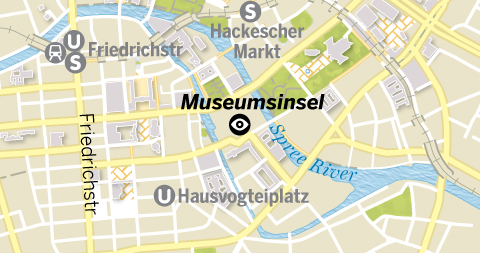
Great For…
 yDon’t Miss
yDon’t Miss
There are fine views of the Museumsinsel from the upstairs cafe terrace at the Humboldt-Box.
 8Need to Know
8Need to Know
If you are planning to visit all five museums, the three-day pass (adult/concession €24/12) is a good deal.
 5Take a Break
5Take a Break
Each of the five museums has its own cafe.
 oTop Tip
oTop Tip
Buy tickets for the Neues Museum and the Pergamonmuseum online at www.smb.museum.
Pergamonmuseum
Opening a fascinating window onto the ancient world, the palatial three-wing complex of the Pergamonmuseum (map Google map; ![]() %030-266 424 242; www.smb.museum; Bodestrasse 1-3; adult/concession/under 18yr €12/6/free;
%030-266 424 242; www.smb.museum; Bodestrasse 1-3; adult/concession/under 18yr €12/6/free; ![]() h10am-6pm Fri-Wed, to 8pm Thu;
h10am-6pm Fri-Wed, to 8pm Thu; ![]() g100, 200, TXL,
g100, 200, TXL, ![]() bHackescher Markt, Friedrichstrasse,
bHackescher Markt, Friedrichstrasse, ![]() b
Friedrichstrasse) unites a rich feast of classical sculpture and monumental architecture from Greece, Rome, Babylon and the Middle East, including the radiant-blue Ishtar Gate from Babylon, the Roman Market Gate of Miletus and the Caliph’s Palace of Mshatta. Renovations put the namesake Pergamon Altar off limits until 2023. Budget at least two hours for this amazing place and be sure to pick up the free and excellent audioguide.
b
Friedrichstrasse) unites a rich feast of classical sculpture and monumental architecture from Greece, Rome, Babylon and the Middle East, including the radiant-blue Ishtar Gate from Babylon, the Roman Market Gate of Miletus and the Caliph’s Palace of Mshatta. Renovations put the namesake Pergamon Altar off limits until 2023. Budget at least two hours for this amazing place and be sure to pick up the free and excellent audioguide.
The Pergamon unites three major collections, the Antikensammlung (Collection of Classical Antiquities), the Museum für Islamische Kunst (Museum of Islamic Art) and the Vorderasiatisches Museum (Museum of Near Eastern Antiquities). The temporary entrance first leads you to the last of these, into the world of Babylon during the reign of King Nebuchadnezzar II. It’s impossible not to be awed by the reconstructed Ishtar Gate, the Processional Way leading up to it and the facade of the king’s throne hall. All are sheathed in glazed bricks glistening in radiant blue and ochre. The strutting lions, horses and dragons, which represent major Babylonian gods, are so striking that you can almost hear the roaring and fanfare.
Another key exhibit on the ground floor is the giant Market Gate of Miletus (2nd century AD). Merchants and customers once flooded through here onto the market square of this Roman trading town (in today’s Turkey) that functioned as a link between Asia and Europe.
Aside from the caliph’s palace, a major standout upstairs in the Islamic collection is the 17th-century Aleppo Room from the house of a Christian merchant in Syria, with its richly painted, wood-panelled walls. If you look closely, you can make out The Last Supper and Mother and Child amid all the ornamentation (straight ahead, to the right of the door).
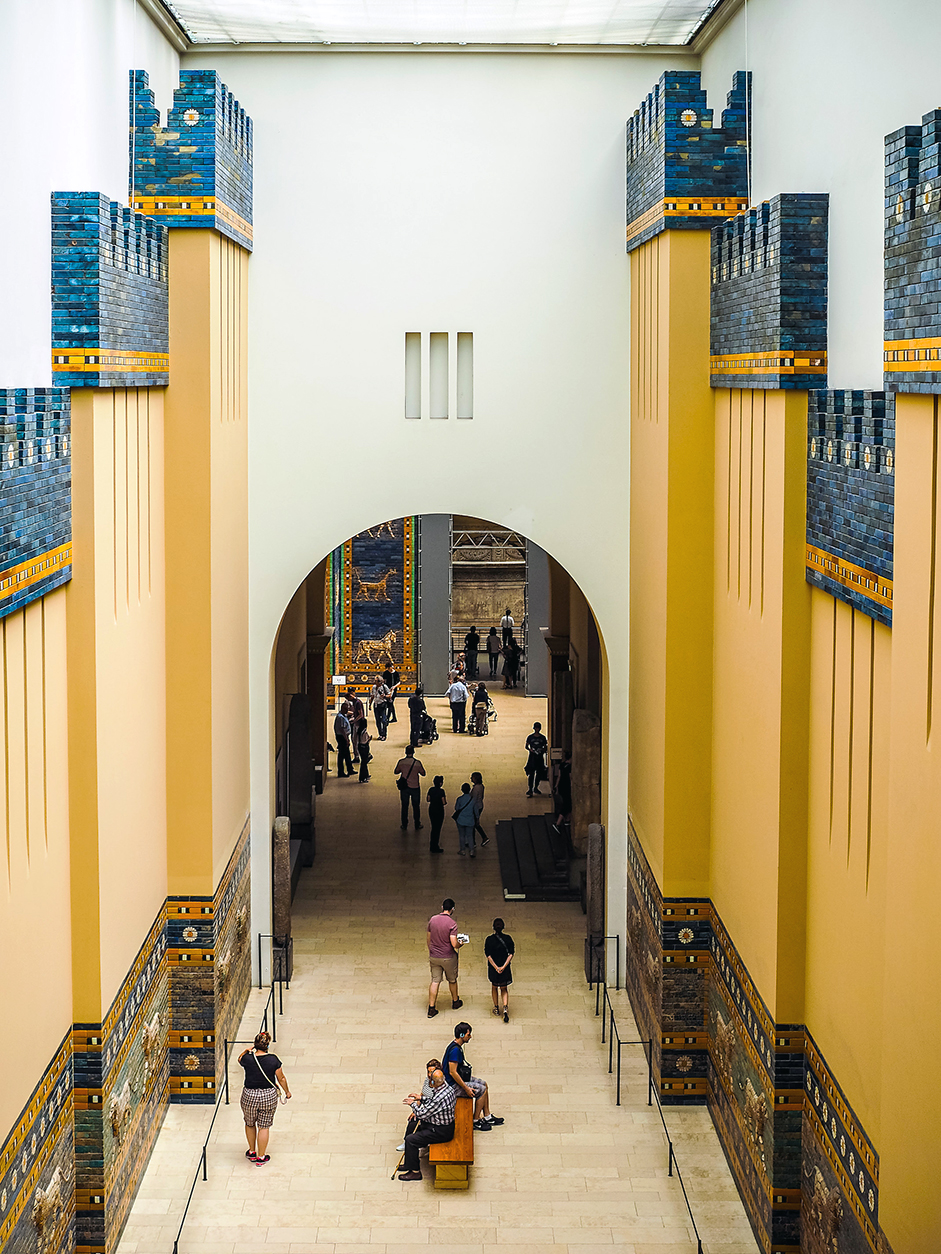
Neues Museum
David Chipperfield’s reconstruction of the bombed-out New Museum (map Google map; ![]() %030-266 424 242; www.smb.museum; Bodestrasse 1-3; adult/concession/under 18yr €12/6/free;
%030-266 424 242; www.smb.museum; Bodestrasse 1-3; adult/concession/under 18yr €12/6/free; ![]() h10am-6pm Fri-Wed, to 8pm Thu;
h10am-6pm Fri-Wed, to 8pm Thu; ![]() g100, 200, TXL,
g100, 200, TXL, ![]() bHackescher Markt, Friedrichstrasse,
bHackescher Markt, Friedrichstrasse, ![]() b
Friedrichstrasse) is now the residence of Queen Nefertiti, the show-stopper of the Egyptian Museum that also features mummies, sculptures and sarcophagi. Pride of place of the Museum of Pre- and Early History in the same building goes to Trojan antiquities, a Neanderthal skull and the 3000-year-old ‘Berliner Goldhut’, a golden conical hat. Skip the queue by buying your timed ticket online.
b
Friedrichstrasse) is now the residence of Queen Nefertiti, the show-stopper of the Egyptian Museum that also features mummies, sculptures and sarcophagi. Pride of place of the Museum of Pre- and Early History in the same building goes to Trojan antiquities, a Neanderthal skull and the 3000-year-old ‘Berliner Goldhut’, a golden conical hat. Skip the queue by buying your timed ticket online.
Altes Museum
A curtain of fluted columns gives way to the Pantheon-inspired rotunda of the grand neoclassical Old Museum (map Google map; ![]() %030-266 424 242; www.smb.museum; Am Lustgarten; adult/concession/under 18 €10/5/free;
%030-266 424 242; www.smb.museum; Am Lustgarten; adult/concession/under 18 €10/5/free; ![]() h10am-6pm Tue, Wed & Fri-Sun, to 8pm Thu;
h10am-6pm Tue, Wed & Fri-Sun, to 8pm Thu; ![]() g100, 200, TXL,
g100, 200, TXL, ![]() bFriedrichstrasse, Hackescher Markt,
bFriedrichstrasse, Hackescher Markt, ![]() b
Friedrichstrasse), which houses a prized antiquities collection. In the downstairs galleries, sculptures, vases, tomb reliefs and jewellery shed light on various facets of life in ancient Greece, while upstairs the focus is on the Etruscans and Romans. Top draws include the Praying Boy bronze sculpture, Roman silver vessels, an ‘erotic cabinet’ (over 18s only!) and portraits of Caesar and Cleopatra.
b
Friedrichstrasse), which houses a prized antiquities collection. In the downstairs galleries, sculptures, vases, tomb reliefs and jewellery shed light on various facets of life in ancient Greece, while upstairs the focus is on the Etruscans and Romans. Top draws include the Praying Boy bronze sculpture, Roman silver vessels, an ‘erotic cabinet’ (over 18s only!) and portraits of Caesar and Cleopatra.
Alte Nationalgalerie
The Greek temple–style Old National Gallery (map Google map; ![]() %030-266 424 242; www.smb.museum; Bodestrasse 1-3; adult/concession €10/5;
%030-266 424 242; www.smb.museum; Bodestrasse 1-3; adult/concession €10/5; ![]() h10am-6pm Tue, Wed & Fri-Sun, to 8pm Thu;
h10am-6pm Tue, Wed & Fri-Sun, to 8pm Thu; ![]() g100, 200, TXL,
g100, 200, TXL, ![]() bHackescher Markt) is a three-storey showcase of 19th-century European art. To get a sense of the period’s virtuosity, pay special attention to the moody landscapes by Romantic heart-throb Caspar David Fried-rich, the epic canvases by Franz Krüger and Adolf Menzel glorifying Prussia, the Gothic fantasies of Karl Friedrich Schinkel, and the sprinkling of French and German impressionists.
bHackescher Markt) is a three-storey showcase of 19th-century European art. To get a sense of the period’s virtuosity, pay special attention to the moody landscapes by Romantic heart-throb Caspar David Fried-rich, the epic canvases by Franz Krüger and Adolf Menzel glorifying Prussia, the Gothic fantasies of Karl Friedrich Schinkel, and the sprinkling of French and German impressionists.

Bode-Museum
On the northern tip of Museumsinsel, the Bode-Museum (map Google map; ![]() %030-266 424 242; www.smb.museum; cnr Am Kupfergraben & Monbijoubrücke; adult/concession/under 18 €12/6/free;
%030-266 424 242; www.smb.museum; cnr Am Kupfergraben & Monbijoubrücke; adult/concession/under 18 €12/6/free; ![]() h10am-6pm Tue, Wed & Fri-Sun, to 8pm Thu;
h10am-6pm Tue, Wed & Fri-Sun, to 8pm Thu; ![]() bHackescher Markt, Friedrichstrasse) houses a comprehensive collection of European sculpture from the early Middle Ages to the 18th century, including priceless masterpieces by Tilman Riemenschenider, Donatello and Giovanni Pisano. Other rooms host a precious coin collection and a smattering of Byzantine art, including sarcophagi and ivory carvings.
bHackescher Markt, Friedrichstrasse) houses a comprehensive collection of European sculpture from the early Middle Ages to the 18th century, including priceless masterpieces by Tilman Riemenschenider, Donatello and Giovanni Pisano. Other rooms host a precious coin collection and a smattering of Byzantine art, including sarcophagi and ivory carvings.
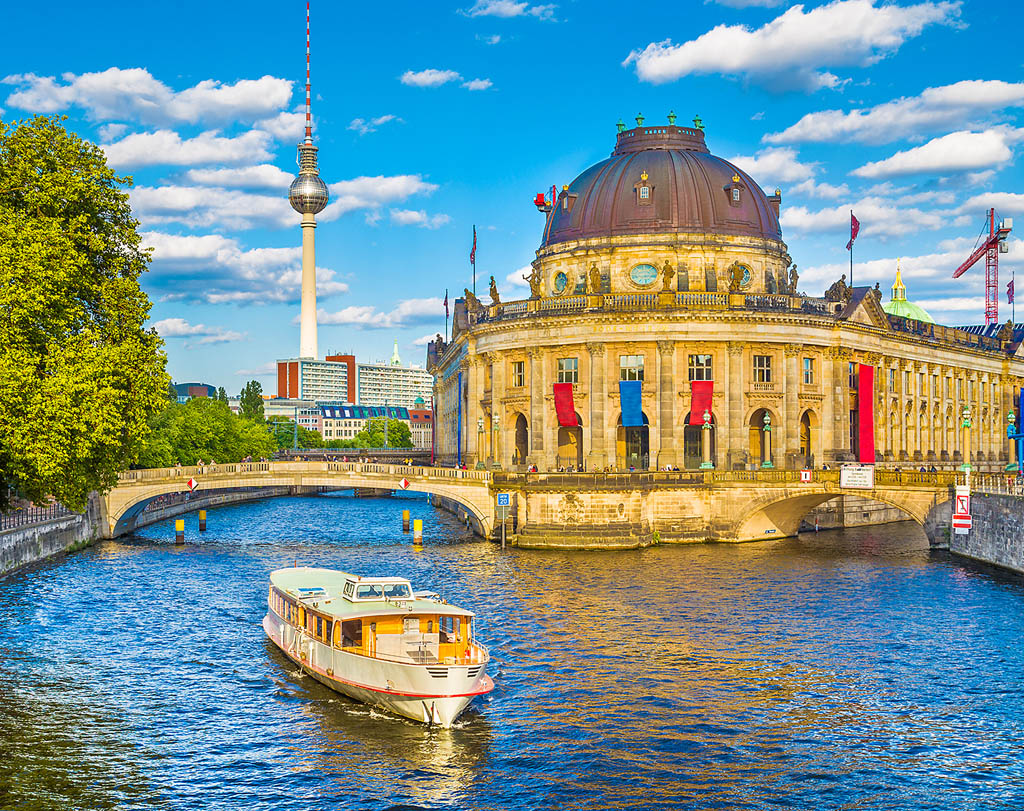
 oComing Soon
oComing Soon
British architect David Chipperfield is currently building an underground walkway called the Archaeological Promenade that will link four of the five museums.
Berliner Dom
Pompous yet majestic, an Italian Renaissance–style former royal court church (1905), the Berlin Cathedral (map Google map; ![]() %ticket office 030-2026 9136; www.berlinerdom.de; Am Lustgarten; adult/concession €7/5;
%ticket office 030-2026 9136; www.berlinerdom.de; Am Lustgarten; adult/concession €7/5; ![]() h9am-8pm Apr-Sep, to 7pm Oct-Mar;
h9am-8pm Apr-Sep, to 7pm Oct-Mar; ![]() g100, 200, TXL,
g100, 200, TXL, ![]() bHackescher Markt) does triple duty as house of worship, museum and concert hall. Inside it’s gilt to the hilt and outfitted with a lavish marble-and-onyx altar, a 7269-pipe Sauer organ and elaborate royal sarcophagi. Climb up the 267 steps to the gallery for glorious city views.
bHackescher Markt) does triple duty as house of worship, museum and concert hall. Inside it’s gilt to the hilt and outfitted with a lavish marble-and-onyx altar, a 7269-pipe Sauer organ and elaborate royal sarcophagi. Climb up the 267 steps to the gallery for glorious city views.
Humboldt-Box
This futuristic five-floor structure (map Google map; ![]() %030-2927 8248; www.humboldt-box.com; Schlossplatz 5;
%030-2927 8248; www.humboldt-box.com; Schlossplatz 5; ![]() h10am-7pm Mar-Nov, to 6pm Dec-Feb;
h10am-7pm Mar-Nov, to 6pm Dec-Feb; ![]() g100, 200, TXL,
g100, 200, TXL, ![]() b
Hausvogteiplatz)
b
Hausvogteiplatz) ![]() F opens up a window on the Berlin City Palace, to be called ‘Humboldt-Forum’, whose reconstruction has been underway since 2013. On display are interactive teasers from each future resident – the Ethnological Museum, the Museum of Asian Art and the Central Library – along with a fantastically detailed model of the historic city centre.
F opens up a window on the Berlin City Palace, to be called ‘Humboldt-Forum’, whose reconstruction has been underway since 2013. On display are interactive teasers from each future resident – the Ethnological Museum, the Museum of Asian Art and the Central Library – along with a fantastically detailed model of the historic city centre.
 8Did You Know?
8Did You Know?
Museumsinsel is the product of a late-19th-century fad mong European royalty to open their private collections to the public. The Louvre in Paris and the British Museum in London both date to this period. In Berlin, King Friedrich Wilhelm III and his successors followed suit.
TOP EXPERIENCE
Schloss Charlottenburg
This exquisite baroque pile is the finest of Berlin’s nine remaining royal palaces. Inspired by Versailles, it backs up against an idyllic park, complete with carp pond, rhododendron-lined paths, two smaller palaces and a mausoleum.
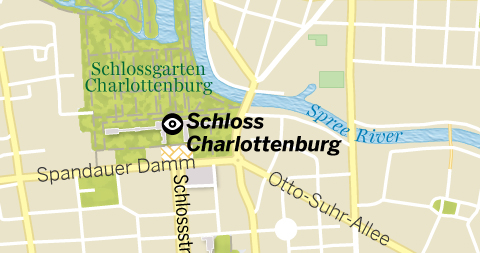
Great For…
 yDon’t Miss
yDon’t Miss
Combine a visit to the palace with a spin round the local museums.
 8Need to Know
8Need to Know
map Google map; ![]() %030-320 910; www.spsg.de; Spandauer Damm 10-22;
%030-320 910; www.spsg.de; Spandauer Damm 10-22; ![]() hhours vary by building;
hhours vary by building; ![]() gM45, 109, 309,
gM45, 109, 309, ![]() b
Richard-Wagner-Platz, Sophie-Charlotte-Platz
b
Richard-Wagner-Platz, Sophie-Charlotte-Platz
 5Take a Break
5Take a Break
Kleine Orangerie (map Google map; ![]() %030-322 2021; mains €6-15;
%030-322 2021; mains €6-15; ![]() h10am-6pm Tue-Sun) is located near the entrance to the palace park.
h10am-6pm Tue-Sun) is located near the entrance to the palace park.
 oTop Tip
oTop Tip
Each building charges separate admission but a day pass called charlottenburg+Combined Ticket (adult/concession €17/13) is available.
We can guarantee that your camera will have a love affair with this late-baroque jewel. The palace itself is clad in a subtle yellow, typical of the royal Hohenzollern family, and wonderfully adorned with slender columns and geometrically arranged windows. An ornate copper-domed tower overlooks the forecourt and the imposing equestrian statue of the ‘Great Elector’ Friedrich Wilhelm. There’s a lot to see here so allow at least three hours.
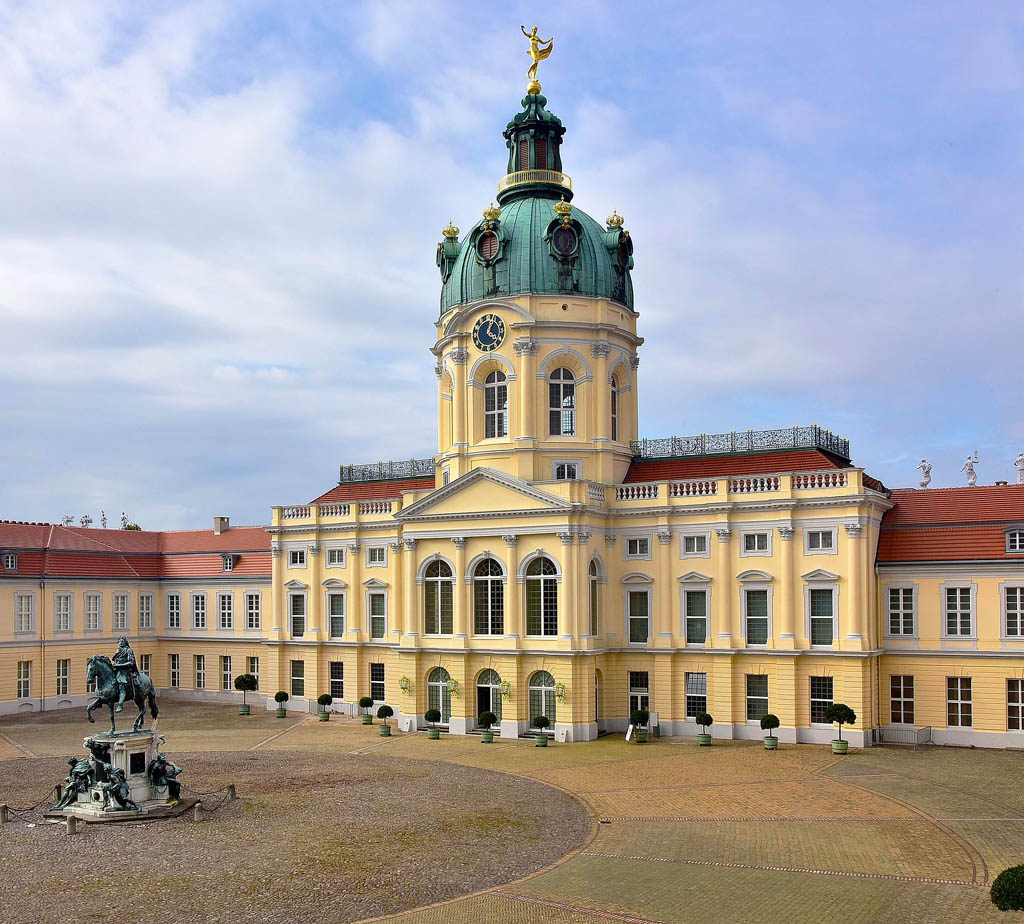
Altes Schloss
Also known as the Nering-Eosander Building after its two architects, the Altes Schloss is the central, and oldest, section of the palace. It is fronted by Andreas Schlüter’s grand equestrian statue of the Great Elector (1699). Inside, the baroque living quarters of Friedrich I and Sophie-Charlotte are an extravaganza in stucco, brocade and overall opulence. Highlights include the Oak Gallery, a wood-panelled festival hall draped in family portraits; the charming Oval Hall overlooking the park; Friedrich I’s bedchamber, with the first-ever proper bathroom in a baroque palace; and the Eosander Chapel, with its trompe l’œil arches. The king’s passion for priceless china is reflected in the dazzling Porcelain Chamber, which is weighed down with almost 3000 pieces of exquisite Chinese and Japanese blueware. Upstairs you will find paintings, vases, tapestries, weapons, porcelain, a 2600-piece silver table setting and many other items the Prussian royals found essential for their lifestyle.
Neuer Flügel
Arguably the most beautiful rooms at Charlottenburg are located in the Neuer Flügel (New Wing). The flamboyant private chambers of King Frederick the Great (r 1740–1786)were designed in 1746 by star architect Georg Wenzeslaus von Knobelsdorff. Standouts include the White Hall banquet room, the gilded Golden Gallery and the paintings by Watteau, Pesne and other 18th-century French masters. In the same wing, the apartments of Queen Luise (1776–1810), wife of King Friedrich Wilhelm III, are decked out with lavish chandeliers, furniture and hand-painted silk wall coverings.

Neuer Pavilion
Returning from a trip to Italy, Friedrich Wilhelm III (r 1797–1848) commissioned Karl Friedrich Schinkel to design this petite summer refuge modelled on a villa in Naples. Today, the minipalace is a sparkling backdrop for masterpieces by such Schinkel-era painters as Caspar David Friedrich and Eduard Gaertner, as well as by the sculptor Christian Daniel Rauch. Ground-floor rooms brim with original Biedermeier furniture.
Schlossgarten
The expansive park behind Schloss Charlottenburg is part formal French, part unruly English and all idyllic playground. Hidden among the shady paths, flower beds, lawns, mature trees and carp pond are two smaller royal buildings, the sombre Mausoleum and the charming Belvedere. It’s a fantastic place for strolling, jogging or lazing on a sunny afternoon. In the summer months take a picnic to enjoy on the grass.
Belvedere
This pint-size palace with the distinctive cupola got its start in 1788 as a teahouse for Friedrich Wilhelm II. Here he enjoyed reading, music and holding spiritual sessions with the mystical Order of the Rosicrucians. These days, the late-rococo vision by Carl Gotthard Langhans makes an elegant backdrop for porcelain masterpieces by the royal manufacturer KPM.
Mausoleum
In the Schlosspark, west of the carp pond, the neoclassical Mausoleum (1810) was conceived as the final resting place of Queen Luise but twice expanded to make room for other royals, including Luise’s husband Friedrich Wilhelm III and Emperor William I and his wife Augusta. Their ornate marble sarcophagi are great works of art. More royals are buried in the crypt (closed to the public).
TOP EXPERIENCE
Holocaust Memorial
A short stroll from the Brandenburg Gate, this vast memorial to Europe’s Jews who were murdered by the Nazis leaves few untouched. The design, hundreds of concrete columns rising from the ground, creates an unforgettable effect.
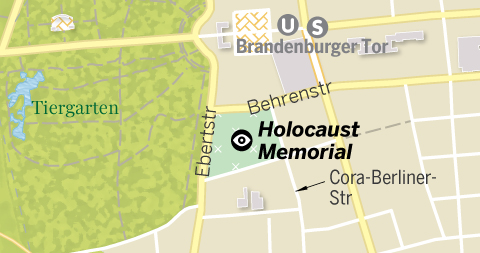
Great For…
 yDon’t Miss
yDon’t Miss
Worthwhile audioguides are available from the Ort der Information.
 8Need to Know
8Need to Know
map Google map; ![]() %030-2639 4336; www.stiftung-denkmal.de; Cora-Berliner-Strasse 1; audioguide €3;
%030-2639 4336; www.stiftung-denkmal.de; Cora-Berliner-Strasse 1; audioguide €3; ![]() h24hr;
h24hr; ![]() bBrandenburger Tor,
bBrandenburger Tor, ![]() b
Brandenburger Tor
b
Brandenburger Tor ![]() F
F
 5Take a Break
5Take a Break
Although you have to pay to get up there, the café at Panoramapunkt has unrivalled views over Mitte.
 oTop Tip
oTop Tip
Visit after dark when the columns are dramatically uplit.
Inaugurated in 2005, this football-field-sized memorial (the official name is the Memorial to the Murdered Jews of Europe) by American architect Peter Eisenman consists of 2711 sarcophagi-like concrete columns rising from 19,000 sq m of undulating ground. The memorial has no designated entrance or exit – you’re free to access this maze at any point and make your individual journey through it. The design is purposefully disorientating, the columns at slightly different heights than those around them and the walkways creating a claustrophobic effect. At busy times many visitors can be seen sitting on the smaller blocks in contemplation of the memorial’s meaning. Some have criticised the memorial for not including others murdered by the Nazis, such as homosexuals, Roma and people with disabilities, though other memorials have been built to these groups.

Conception & Construction
A holocaust memorial was a long time in the making, the idea having been put forward in the 1980s. It wasn’t until 1994 that a competition for the design was launched, with the winning artist to receive a budget of €25 million. The two shortlisted designs were eventually vetoed by Chancellor Kohl and a new competition was announced in 1996. The next year Peter Eisenman’s design was announced as winner though the original plan had 4,000 pillars. Construction began in 2003 and was opened to the public in May 2005. It’s estimated around three million visitors walk through the memorial every year, making it one of Berlin’s top attractions.
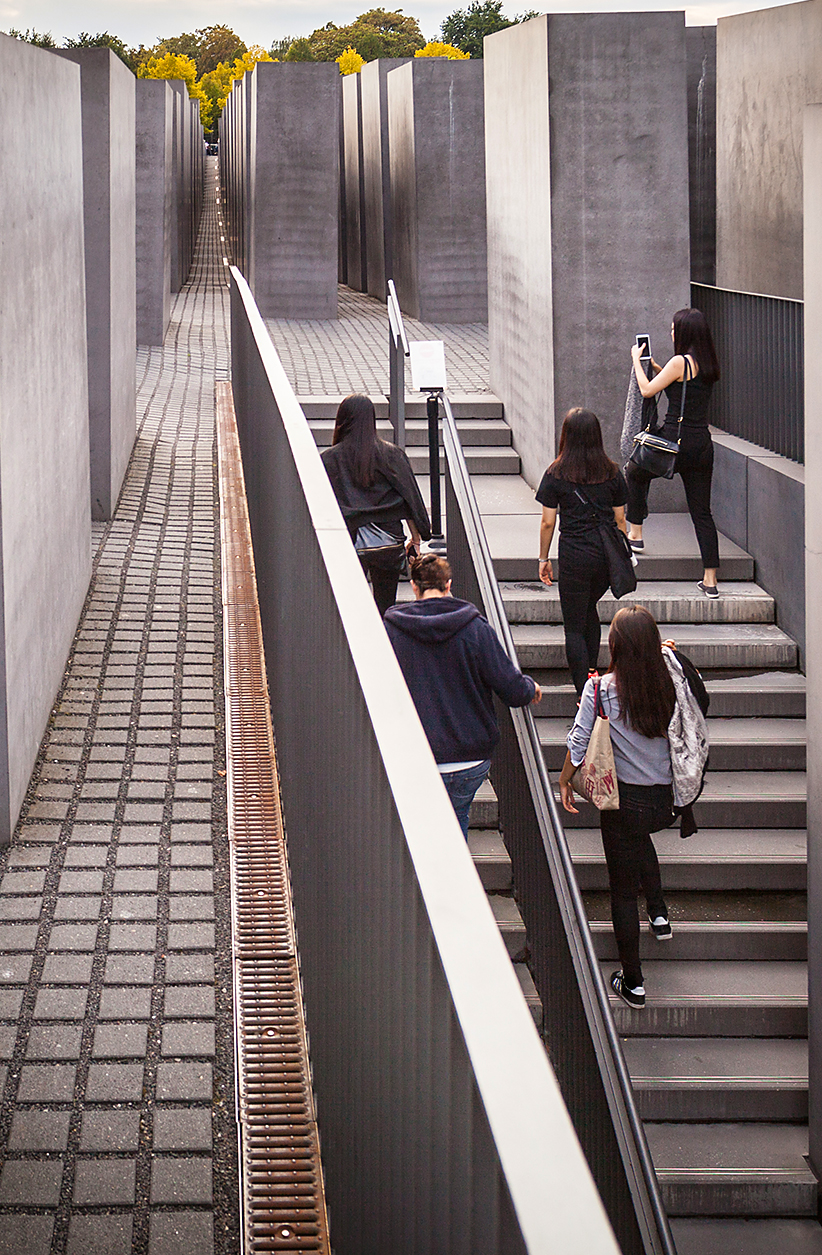
Ort der Information
For context, visit the subterranean Ort der Information (Information Centre) whose exhibits are thought-provoking at the very least. The entrance is on the eastern side of the memorial, near Cora-Berliner-Strasse.
What’s Nearby
It’s ironic that the Site of Hitler’s bunker (Führerbunker; map Google map; cnr In den Ministergärten & Gertrud-Kolmar-Strasse; ![]() h24hr;
h24hr; ![]() bBrandenburger Tor,
bBrandenburger Tor, ![]() b
Brandenburger Tor) is located only a short walk southeast of the Holocaust Memorial. As Berlin burnt and Soviet tanks advanced relentlessly towards the city centre, it was here that Adolf Hitler committed suicide on 30 April 1945, alongside Eva Braun, his long-time companion, hours after their marriage. The bodies were never found. Today, a modern parking lot just off Gertrud-Kolmar-Strasse covers the site, revealing its dark history only via an information panel with a diagram of the vast bunker network, construction data and the site’s post-WWII history.
b
Brandenburger Tor) is located only a short walk southeast of the Holocaust Memorial. As Berlin burnt and Soviet tanks advanced relentlessly towards the city centre, it was here that Adolf Hitler committed suicide on 30 April 1945, alongside Eva Braun, his long-time companion, hours after their marriage. The bodies were never found. Today, a modern parking lot just off Gertrud-Kolmar-Strasse covers the site, revealing its dark history only via an information panel with a diagram of the vast bunker network, construction data and the site’s post-WWII history.
TOP EXPERIENCE
Berlin Nightlife
With its well-deserved reputation as one of Europe’s primo party capitals, Berlin offers a thousand-and-one scenarios for getting your cocktails and kicks (or wine or beer, for that matter).
Great For…
 yDon’t Miss
yDon’t Miss
Café am Neuen See is one of Berlin’s best beer gardens.
 8Need to Know
8Need to Know
Regular bars start up around 6pm and close at 1am or 2am the next day. Trendy places and cocktail bars don’t open until 8pm or 9pm and stay open until the last tippler leaves. Clubs open at 11pm or midnight but don’t fill up until 1am or 2am, reaching their peak between 4am and 6am (many open only on Friday and Saturday nights).
 5Take a Break
5Take a Break
Check out the food offerings while you’re chilling out in one of Berlin’s beer gardens or enjoying the views from a rooftop bar.
 oTop Tip
oTop Tip
There’s generally no need to dress up at Berlin’s clubs and getting past bouncers is fairly easy.
Bars & Cafes
Berlin is a notoriously late city: bars stay packed from dusk to dawn and beyond, and some clubs don’t hit their stride until 4am. The lack of a curfew meant a tradition of binge drinking was never created.
Edgier, more underground venues cluster in Kreuzberg, Friedrichshain, Neukölln and up-and-coming outer boroughs like Wedding (north of Mitte) and Lichtenberg (past Friedrichshain). Places in Charlottenburg, Mitte and Prenzlauer Berg tend to be quieter and close earlier. Some proprietors have gone to extraordinary lengths to come up with special design concepts.
The line between cafe and bar is often blurred, with many changing stripes as the hands move around the clock. Alcohol, however, is served pretty much all day. Cocktail bars are booming in Berlin and several new arrivals have measurably elevated the ‘liquid art’ scene. Dedicated drinking dens tend to be elegant cocoons with mellow lighting and low sound levels. A good cocktail will set you back between €10 and €15.
Although still lower than in other major capital cities, drinks prices have crept up over the last couple of years.
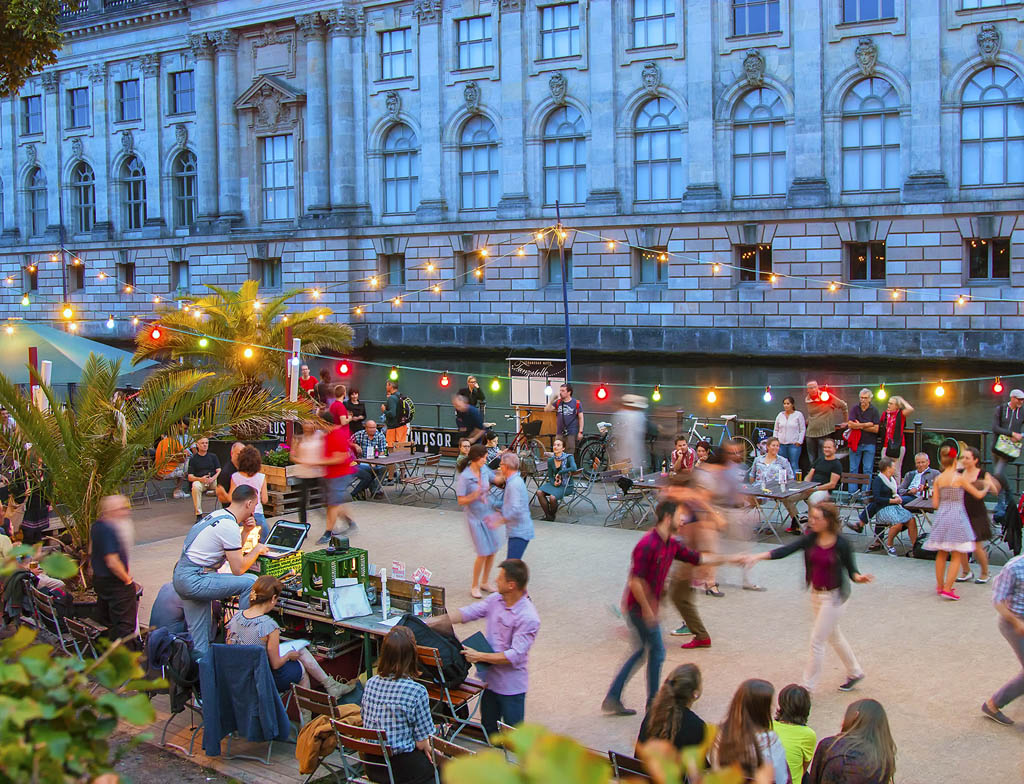
Beaches & Outdoor Drinking
Berliners are sun cravers. As soon as the first rays spray their way into spring, outdoor tables show up faster than you can pour a pint of beer. The most traditional places for outdoor chilling are, of course, the beer gardens, with long wooden benches set up beneath leafy old chestnuts and cold beer and bratwurst on the menu. In 2002, Berlin also jumped on the ‘sandwagon’ with the opening of its first beach bar, Strandbar Mitte, in a prime location on the Spree River. Many that followed have since been displaced by development, which has partly fuelled the latest trend: rooftop bars.
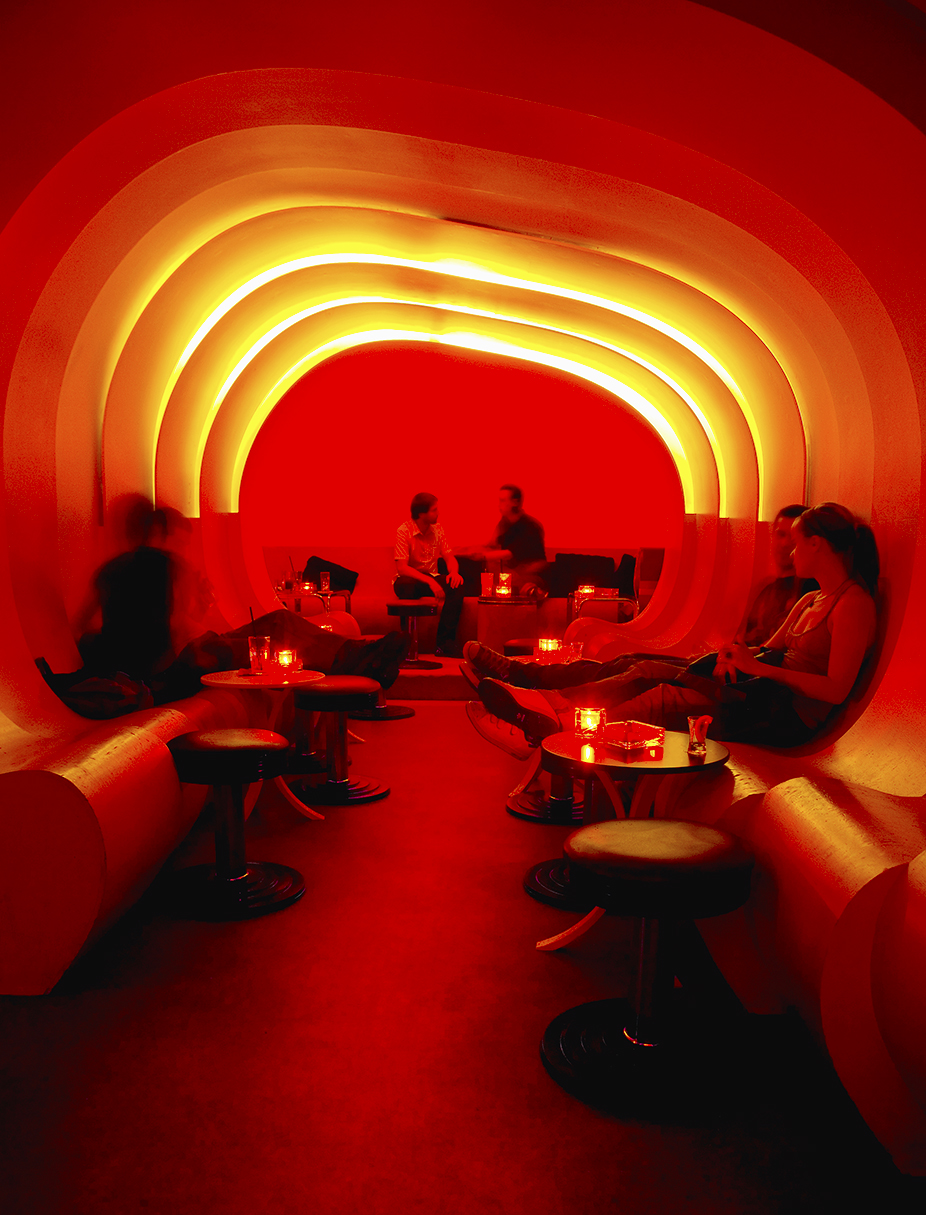
Clubbing
Over the past 25 years, Berlin’s club culture has put the city firmly on the map of hedonists. With more than 200 venues, finding one to match your mood isn’t difficult. Electronic music in its infinite varieties continues to define Berlin’s after dark action but other sounds like hip-hop, dancehall, rock, swing and funk have also made inroads. The edgiest clubs have taken up residence in power plants, transformer stations, abandoned apartment buildings and other repurposed locations. The scene is in constant flux as experienced club owners look for new challenges and a younger generation of promoters enters the scene with new ideas and impetus.
1Sights
Berlin is split into 12 official Bezirke (districts; for example, Mitte, Prenzlauer Berg, Kreuzberg), which are subdivided into individual Kieze (neighbourhoods). Key sights such as the Brandenburger Tor and Museumsinsel cluster in the walkable historic city centre – Mitte – which also cradles the fashion-centric Scheunenviertel around Hackescher Markt.

Mitte
1Sights
2Activities, Courses & Tours
5Eating
6Drinking & Nightlife
1Unten den Linten
Deutsches Historisches MuseumMuseum
(German Historical Museum; map Google map; ![]() %030-203 040; www.dhm.de; Unter den Linden 2; adult/concession/child under 18 incl IM Pei Bau €8/4/free;
%030-203 040; www.dhm.de; Unter den Linden 2; adult/concession/child under 18 incl IM Pei Bau €8/4/free; ![]() h10am-6pm;
h10am-6pm; ![]() g100, 200,
g100, 200, ![]() bHausvogteiplatz,
bHausvogteiplatz, ![]() bHackescher Markt)
bHackescher Markt)
If you’re wondering what the Germans have been up to for the past 1500 years, take a spin around the baroque Zeughaus, formerly the Prussian arsenal and now home of the German Historical Museum. Upstairs, displays concentrate on the period from the 6th century AD to the end of WWI in 1918, while the ground floor tracks the 20th century all the way through to the early years after German reunification.
1Friedrichstrasse
GendarmenmarktSquare
(map Google map; ![]() bFranzösische Strasse, Stadtmitte) This graceful square is bookended by the domed German and French cathedrals and punctuated by a grandly porticoed concert hall, the Konzerthaus (map Google map;
bFranzösische Strasse, Stadtmitte) This graceful square is bookended by the domed German and French cathedrals and punctuated by a grandly porticoed concert hall, the Konzerthaus (map Google map; ![]() %030-203 092 333; www.konzerthaus.de; Gendarmenmarkt 2).
%030-203 092 333; www.konzerthaus.de; Gendarmenmarkt 2).
It was named for the Gens d’Armes, an 18th-century Prussian regiment consisting of French Huguenot refugees.
Checkpoint CharlieHistoric Site
(map Google map; cnr Zimmerstrasse & Friedrichstrasse; ![]() h24hr;
h24hr; ![]() bKochstrasse)
bKochstrasse) ![]() F
F
Checkpoint Charlie was the principal gateway for foreigners and diplomats between the two Berlins from 1961 to 1990. Unfortunately, this potent symbol of the Cold War has degenerated into a tacky tourist trap, though a free open-air exhibit that illustrates milestones in Cold War history is one redeeming aspect.
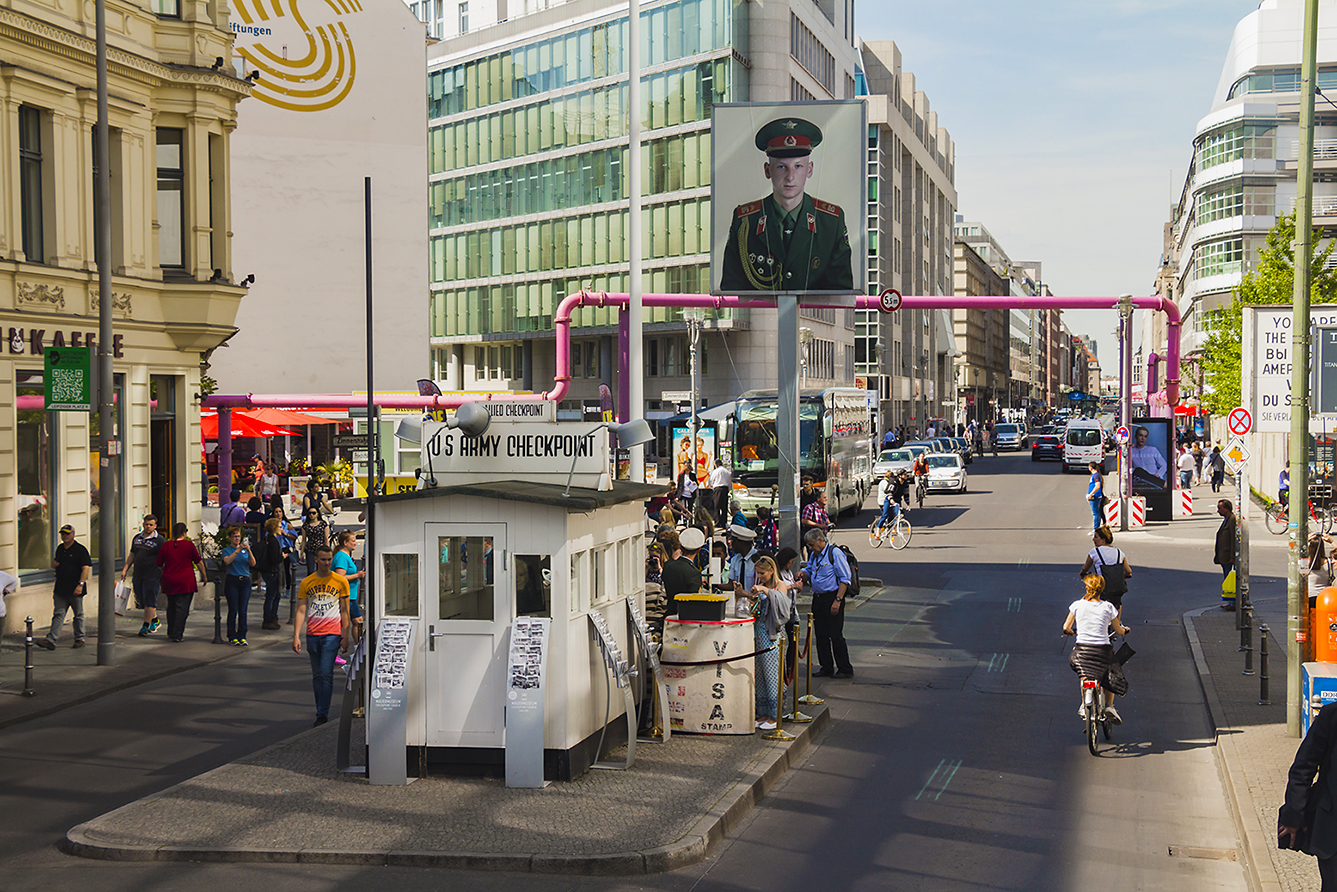
Museum für Kommunikation BerlinMuseum
(map Google map; ![]() %030-202 940; www.mfk-berlin.de; Leipziger Strasse 16; adult/concession/child under 17 €5/3/free;
%030-202 940; www.mfk-berlin.de; Leipziger Strasse 16; adult/concession/child under 17 €5/3/free; ![]() h9am-8pm Tue, 9am-5pm Wed-Fri, 10am-6pm Sat & Sun;
h9am-8pm Tue, 9am-5pm Wed-Fri, 10am-6pm Sat & Sun; ![]() g200,
g200, ![]() bMohrenstrasse, Stadtmitte)
bMohrenstrasse, Stadtmitte)
Three cheeky robots welcome you to this elegant, neo-baroque museum, which takes you on an entertaining romp through the evolution of communication, from smoke signals to smartphones. Admire such rare items as a Blue Mauritius stamp or one of the world’s first telephones, test milestones in communication techniques, or ponder the impact of information technology on our daily lives.
1Scheunenviertel
Hackesche HöfeHistoric Site
(Hackesche Courtyards; map Google map; ![]() %030-2809 8010; www.hackesche-hoefe.com; enter from Rosenthaler Strasse 40/41 or Sophienstrasse 6;
%030-2809 8010; www.hackesche-hoefe.com; enter from Rosenthaler Strasse 40/41 or Sophienstrasse 6; ![]() jM1,
jM1, ![]() bHackescher Markt,
bHackescher Markt, ![]() bWeinmeisterstrasse)
bWeinmeisterstrasse)
The Hackesche Höfe is the largest and most famous of the courtyard ensembles peppered throughout the Scheunenviertel. Built in 1907, the eight interlinked Höfe reopened in 1996 with a congenial mix of cafes, galleries, shops and entertainment venues. The main entrance on Rosenthaler Strasse leads to Court I, prettily festooned with art nouveau tiles, while Court VII segues to the romantic Rosenhöfe with a sunken rose garden and tendril-like balustrades.
Hamburger Bahnhof – Museum für GegenwartMuseum
(Contemporary Art Museum; map Google map; ![]() %030-266 424 242; www.smb.museum; Invalidenstrasse 50-51; adult/concession €10/5, free 4-8pm 1st Thu of the month;
%030-266 424 242; www.smb.museum; Invalidenstrasse 50-51; adult/concession €10/5, free 4-8pm 1st Thu of the month; ![]() h10am-6pm Tue, Wed & Fri, to 8pm Thu, 11am-6pm Sat & Sun;
h10am-6pm Tue, Wed & Fri, to 8pm Thu, 11am-6pm Sat & Sun; ![]() jM5, M8, M10,
jM5, M8, M10, ![]() bHauptbahnhof,
bHauptbahnhof, ![]() bHauptbahnhof)
bHauptbahnhof)
Berlin’s contemporary art showcase opened in 1996 in an old railway station, whose grandeur is a great backdrop for this Aladdin’s cave of paintings, installations, sculptures and video art. Changing exhibits span the arc of post-1950 artistic movements – from conceptual art and pop art to minimal art and Fluxus – and include seminal works by such major players as Andy Warhol, Cy Twombly, Joseph Beuys and Robert Rauschenberg.
Sachsenhausen Concentration Camp
About 35km north of Berlin, Sachsenhausen (Memorial & Museum Sachsenhausen; ![]() %03301-200 200; www.stiftung-bg.de; Strasse der Nationen 22, Oranienburg;
%03301-200 200; www.stiftung-bg.de; Strasse der Nationen 22, Oranienburg; ![]() h8.30am-6pm mid-Mar–mid-Oct, to 4.30pm mid-Oct–mid-Mar, museums closed Mon mid-Oct–mid-Mar;
h8.30am-6pm mid-Mar–mid-Oct, to 4.30pm mid-Oct–mid-Mar, museums closed Mon mid-Oct–mid-Mar; ![]() p;
p; ![]() bOranienburg)
bOranienburg) ![]() F was built by prisoners and opened in 1936 as a prototype for other camps. By 1945, some 200,000 people had passed through its sinister gates, most of them political opponents, Jews, Roma people and, after 1939, POWs. Tens of thousands died here from hunger, exhaustion, illness, exposure, medical experiments and executions. A tour of the memorial site with its remaining buildings and exhibits will leave no one untouched.
F was built by prisoners and opened in 1936 as a prototype for other camps. By 1945, some 200,000 people had passed through its sinister gates, most of them political opponents, Jews, Roma people and, after 1939, POWs. Tens of thousands died here from hunger, exhaustion, illness, exposure, medical experiments and executions. A tour of the memorial site with its remaining buildings and exhibits will leave no one untouched.
Thousands more succumbed during the death march of April 1945, when the Nazis evacuated the camp in advance of the Red Army. Note the memorial plaque to these victims as you walk towards the camp from S-Bahnstation Oranienburg (at the corner of Strasse der Einheit and Strasse der Nationen).

Museum für NaturkundeMuseum
(Museum of Natural History; map Google map; ![]() %030-2093 8591; www.naturkundemuseum.berlin; Invalidenstrasse 43; adult/concession incl audioguide €8/5;
%030-2093 8591; www.naturkundemuseum.berlin; Invalidenstrasse 43; adult/concession incl audioguide €8/5; ![]() h9.30am-6pm Tue-Fri, 10am-6pm Sat & Sun;
h9.30am-6pm Tue-Fri, 10am-6pm Sat & Sun; ![]() c;
c; ![]() jM5, M8, M10, 12,
jM5, M8, M10, 12, ![]() bNaturkundemuseum)
bNaturkundemuseum)
Fossils and minerals don’t quicken your pulse? Well, how about Tristan, the T-Rex? His skeleton is among the best-preserved in the world and, along with the 12m-high Brachiosaurus branchai, part of the Jurassic superstar line-up at this highly engaging museum. Elsewhere you can wave at Knut, the world’s most famous dead polar bear; marvel at the fragile bones of an ultrarare Archaeopteryx protobird, and find out why zebras are striped.
Neue SynagogeSynagogue
(map Google map; ![]() %030-8802 8300; www.centrumjudaicum.de; Oranienburger Strasse 28-30; adult/concession €5/4, audioguide €3;
%030-8802 8300; www.centrumjudaicum.de; Oranienburger Strasse 28-30; adult/concession €5/4, audioguide €3; ![]() h10am-6pm Mon-Fri, to 7pm Sun, closes 3pm Fri & 6pm Sun Oct-Mar;
h10am-6pm Mon-Fri, to 7pm Sun, closes 3pm Fri & 6pm Sun Oct-Mar; ![]() jM1,
jM1, ![]() bOranienburger Tor,
bOranienburger Tor, ![]() bOranienburger Strasse)
bOranienburger Strasse)
The gleaming gold dome of the Neue Synagoge is the most visible symbol of Berlin’s revitalised Jewish community. The 1866 original was Germany’s largest synagogue but its modern incarnation is not so much a house of worship (although prayer services do take place), as a museum and place of remembrance called Centrum Judaicum. The dome can be climbed from April to September (adult/concession €3/2.50).
1Alexanderplatz
FernsehturmLandmark
(TV Tower; map Google map; ![]() %030-247 575 875; www.tv-turm.de; Panoramastrasse 1a; adult/child €15.50/9.50, fast track online ticket €19.50/12;
%030-247 575 875; www.tv-turm.de; Panoramastrasse 1a; adult/child €15.50/9.50, fast track online ticket €19.50/12; ![]() h9am-midnight Mar-Oct, 10am-midnight Nov-Feb, last ascent 11.30pm;
h9am-midnight Mar-Oct, 10am-midnight Nov-Feb, last ascent 11.30pm; ![]() g100, 200, TXL,
g100, 200, TXL, ![]() bAlexanderplatz,
bAlexanderplatz, ![]() bAlexanderplatz)
bAlexanderplatz)
Germany’s tallest structure, the TV Tower has been soaring 368m high since 1969 and is as iconic to Berlin as the Eiffel Tower is to Paris. On clear days, views are stunning from the observation deck (with bar) at 203m or from the upstairs Sphere restaurant (map Google map; www.tv-turm.de/en/bar-restaurant; mains lunch €10.50-18, dinner €12.50-28; ![]() h10am-11pm;
h10am-11pm; ![]() W) at 207m, which makes one revolution per hour.
W) at 207m, which makes one revolution per hour.
DDR MuseumMuseum
(GDR (East Germany) Museum; map Google map; ![]() %030-847 123 731; www.ddr-museum.de; Karl-Liebknecht-Strasse 1; adult/concession €9.80/6;
%030-847 123 731; www.ddr-museum.de; Karl-Liebknecht-Strasse 1; adult/concession €9.80/6; ![]() h10am-8pm Sun-Fri, to 10pm Sat;
h10am-8pm Sun-Fri, to 10pm Sat; ![]() g100, 200, TXL,
g100, 200, TXL, ![]() bHackescher Markt)
bHackescher Markt)
This touchy-feely museum does an insightful and entertaining job of pulling back the iron curtain on daily life in socialist East Germany. You’ll learn how kids were put through collective potty training, engineers earned little more than farmers, and everyone, it seems, went on nudist holidays. A perennial crowd-pleaser among the historic objects on display is a Trabi, the tinny East German standard car – sit in it to take a virtual spin around an East Berlin neighbourhood.
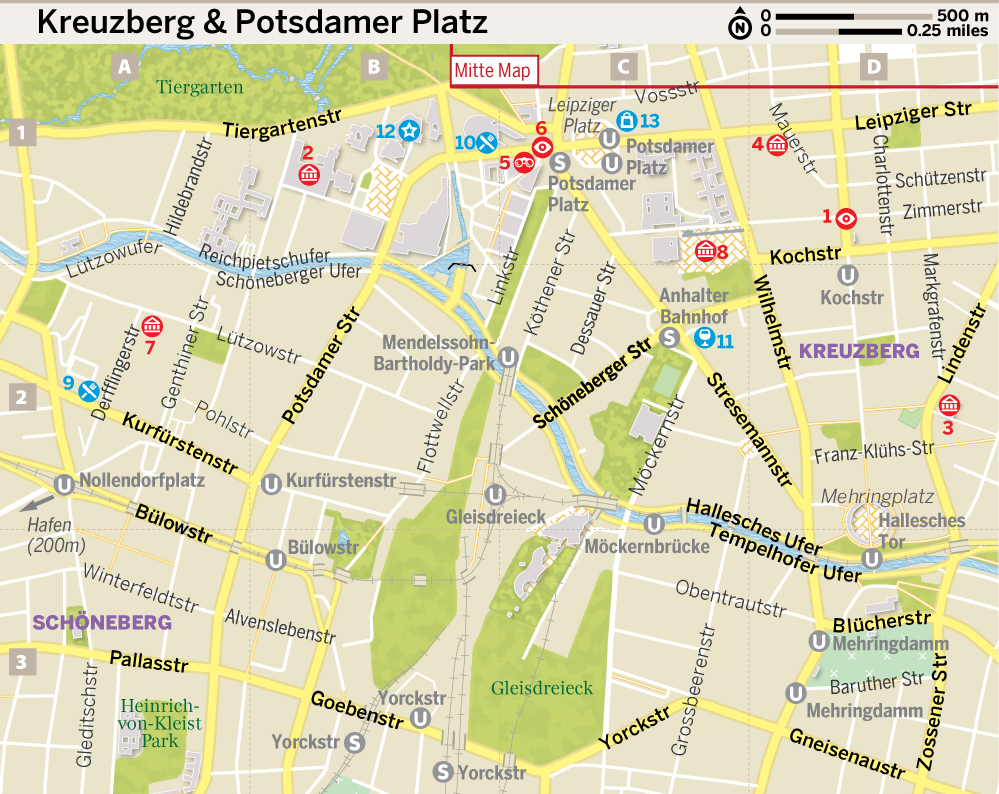
Kreuzberg & Potsdamer Platz
1Sights
6Drinking & Nightlife
3Entertainment
7Shopping
1Potsdamer Platz & Tiergarten
This new quarter, forged from ground once bisected by the Berlin Wall, is a showcase of fabulous contemporary architecture and home to big cinemas and shopping. Culture lovers should not skip the Kulturforum museums, especially the Gemäldegalerie, which sits right next to the world-class Berliner Philharmonie. The leafy Tiergarten, with its rambling paths, monuments and hidden beer gardens, makes for a perfect sightseeing break.
Europe’s fastest lift, Panoramapunkt (map Google map; ![]() %030-2593 7080; www.panoramapunkt.de; Potsdamer Platz 1; adult/concession €7.50/6, without wait €11.50/9;
%030-2593 7080; www.panoramapunkt.de; Potsdamer Platz 1; adult/concession €7.50/6, without wait €11.50/9; ![]() h10am-8pm Apr-Oct, to 6pm Nov-Mar;
h10am-8pm Apr-Oct, to 6pm Nov-Mar; ![]() gM41, 200,
gM41, 200, ![]() bPotsdamer Platz,
bPotsdamer Platz, ![]() bPotsdamer Platz), yo-yoes up and down the red-brick postmodern Kollhof Tower. From the bi-level viewing platform at a lofty 100m, you can pinpoint the sights, make a java stop in the 1930s-style cafe, enjoy sunset from the terrace and check out the exhibit that peels back the layers of the quarter’s history.
bPotsdamer Platz), yo-yoes up and down the red-brick postmodern Kollhof Tower. From the bi-level viewing platform at a lofty 100m, you can pinpoint the sights, make a java stop in the 1930s-style cafe, enjoy sunset from the terrace and check out the exhibit that peels back the layers of the quarter’s history.
TiergartenPark
(Strasse des 17 Juni; ![]() g100, 200,
g100, 200, ![]() bPotsdamer Platz, Brandenburger Tor,
bPotsdamer Platz, Brandenburger Tor, ![]() bBrandenburger Tor)
bBrandenburger Tor)
Berlin’s rulers used to hunt boar and pheasants in the rambling Tiergarten until garden architect Peter Lenné landscaped the grounds in the 19th century. Today it’s one of the world’s largest urban parks, popular for strolling, jogging, picnicking, frisbee tossing and, yes, nude sunbathing and gay cruising (especially around the Löwenbrücke).

Topographie des TerrorsMuseum
(Topography of Terror; map Google map; ![]() %030-2545 0950; www.topographie.de; Niederkirchner Strasse 8;
%030-2545 0950; www.topographie.de; Niederkirchner Strasse 8; ![]() h10am-8pm, grounds close at dusk or 8pm at the latest;
h10am-8pm, grounds close at dusk or 8pm at the latest; ![]() gM41,
gM41, ![]() bPotsdamer Platz,
bPotsdamer Platz, ![]() bPotsdamer Platz)
bPotsdamer Platz) ![]() F
F
In the spot where the most feared institutions of Nazi Germany once stood (including the Gestapo headquarters and the SS central command), this compelling exhibit chronicles the stages of terror and persecution, puts a face on the perpetrators and details the impact these brutal institutions had on all of Europe. A second exhibit outside zeroes in on how life changed for Berlin and its people after the Nazis made it their capital.
GemäldegalerieGallery
(Gallery of Old Masters; map Google map; ![]() %030-266 424 242; www.smb.museum/gg; Matthäikirchplatz; adult/concession/under 18 €10/5/free;
%030-266 424 242; www.smb.museum/gg; Matthäikirchplatz; adult/concession/under 18 €10/5/free; ![]() h10am-6pm Tue, Wed & Fri, to 8pm Thu, 11am-6pm Sat & Sun;
h10am-6pm Tue, Wed & Fri, to 8pm Thu, 11am-6pm Sat & Sun; ![]() c;
c; ![]() gM29, M48, M85, 200,
gM29, M48, M85, 200, ![]() bPotsdamer Platz,
bPotsdamer Platz, ![]() bPotsdamer Platz)
bPotsdamer Platz)
This museum ranks among the world’s finest and most comprehensive collections of European art, with about 1500 paintings spanning the arc of artistic vision from the 13th to the 18th century. Wear comfy shoes when exploring the 72 galleries: a walk past masterpieces by Titian, Dürer, Hals, Vermeer, Gainsborough and many more Old Masters covers almost 2km. Don’t miss the Rembrandt Room (Room X).
1Prenzlauer Berg
Prenzlauer Berg doesn’t have any blockbuster sights, and most of what it does have is concentrated in the pretty southern section around Kollwitzplatz. The neighbourhood does include the city’s most important exhibit on the Berlin Wall, the Gedenkstätte Berliner Mauer (Berlin Wall Memorial), which begins in Wedding and stretches for 1.4km all the way into Prenzlauer Berg.
LGBTIQ+ Berlin
Generally speaking, Berlin’s gayscape runs the entire spectrum from mellow cafes, campy bars and cinemas to saunas, cruising areas, clubs with darkrooms and all-out sex venues. In fact, sex and sexuality are entirely everyday matters to the unshockable city folks and there are very few, if any, itches that can’t be quite openly and legally scratched. As elsewhere, gay men have more options for having fun, but grrrrls of all stripes won’t feel left out either.
Blu (www.blu.fm) Online and freebie-print magazine with searchable, up-to-the-minute location and event listings.
L-Mag (www.l-mag.de) Bimonthly magazine for lesbians.
Siegessäule (www.siegessaeule.de) Free weekly lesbigay ‘bible’.
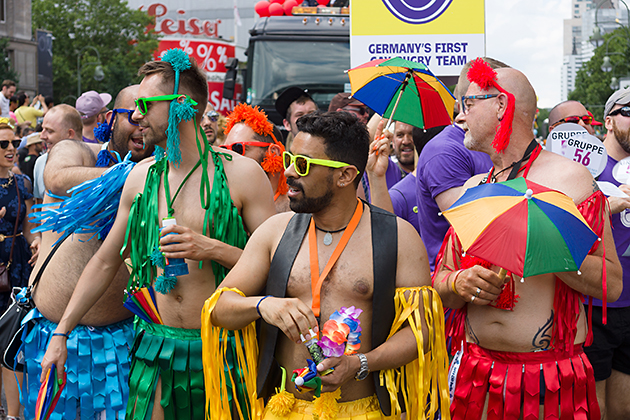
MauerparkPark
(map Google map; www.mauerpark.info; btwn Bernauer Strasse, Schwedter Strasse & Gleimstrasse; ![]() jM1, M10, 12,
jM1, M10, 12, ![]() bEberswalder Strasse)
bEberswalder Strasse)
With its wimpy trees and anaemic lawn, Mauerpark is hardly your typical leafy oasis, especially given that it was forged from a section of Cold War–era death strip (a short stretch of Berlin Wall survives). It’s this mystique combined with an unassuming vibe and a hugely popular Sunday flea market and karaoke show that has endeared the place to locals and visitors alike.
1Friedrichshain
This notorious party district also has a serious side, especially when it comes to blockbuster vestiges of the GDR era such as the East Side Gallery, and Karl-Marx-Allee (map Google map; ![]() bStrausberger Platz, Weberwiese, Frankfurter Tor)
bStrausberger Platz, Weberwiese, Frankfurter Tor) ![]() F. Sights are spread out and best reached by public transport.
F. Sights are spread out and best reached by public transport.
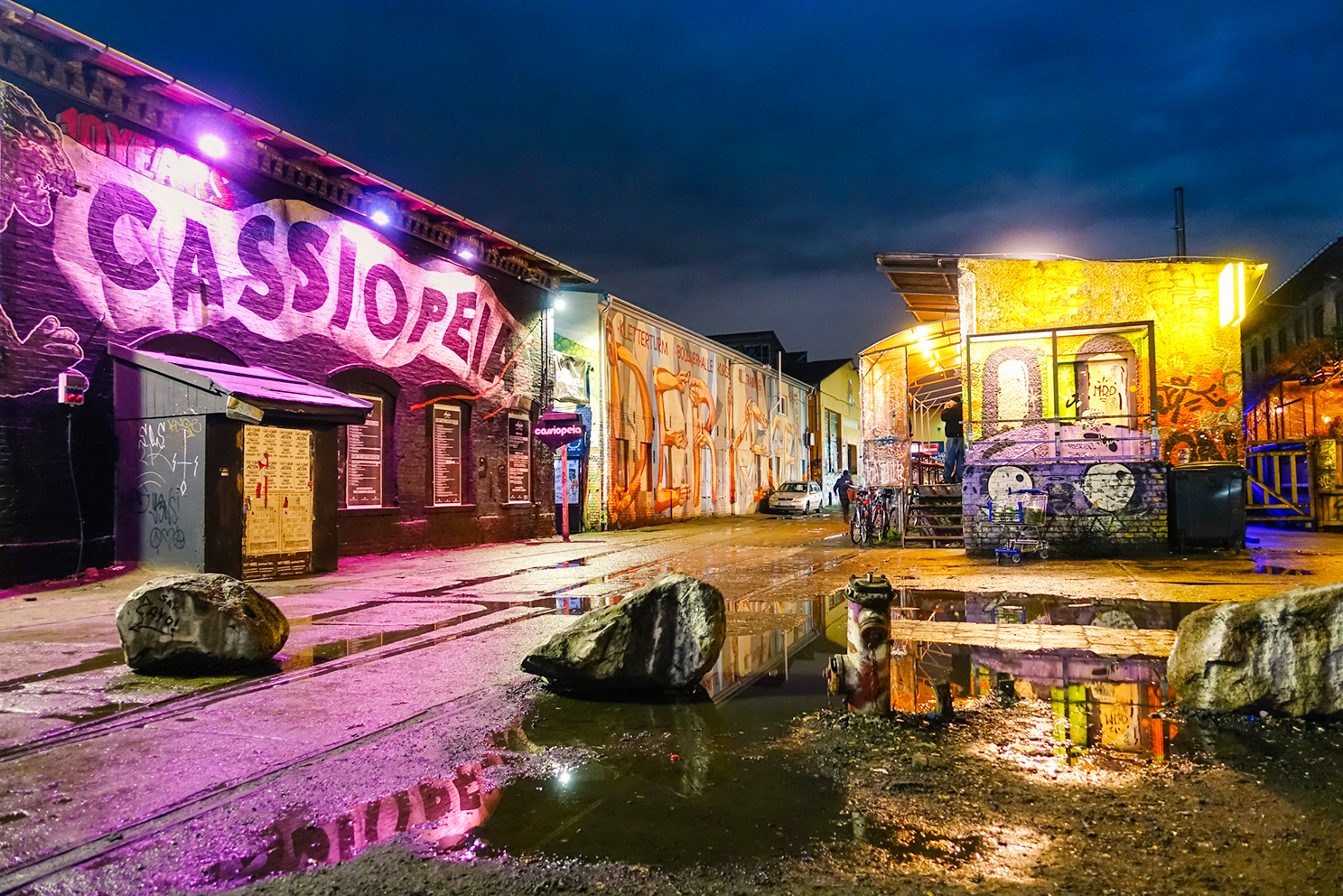
Volkspark FriedrichshainPark
(map Google map; bounded by Am Friedrichshain, Friedenstrasse, Danziger Strasse & Landsberger Allee; ![]() h24hr;
h24hr; ![]() g142, 200,
g142, 200, ![]() j21, M4, M5, M6, M8, M10,
j21, M4, M5, M6, M8, M10, ![]() bSchillingstrasse)
bSchillingstrasse)
Berlin’s oldest public park has provided relief from urban life since 1840, but has been hilly only since the late 1940s, when wartime debris was piled up here to create two ‘mountains’ – the taller one, Mont Klamott ![]() F, rises 78m high. Diversions include expansive lawns for lazing, tennis courts, a half-pipe for skaters, a couple of handily placed beer gardens and an outdoor cinema.
F, rises 78m high. Diversions include expansive lawns for lazing, tennis courts, a half-pipe for skaters, a couple of handily placed beer gardens and an outdoor cinema.
Computerspiele-museumMuseum
(Computer Games Museum; map Google map; ![]() %030-6098 8577; www.computerspielemuseum.de; Karl-Marx-Allee 93a; adult/concession €9/6, after 6pm €7/5;
%030-6098 8577; www.computerspielemuseum.de; Karl-Marx-Allee 93a; adult/concession €9/6, after 6pm €7/5; ![]() h10am-8pm;
h10am-8pm; ![]() g240, 347,
g240, 347, ![]() bWeberwiese)
bWeberwiese)
No matter if you grew up with Nimrod, Pac-Man, World of Warcraft or no games at all, this well-curated museum takes you on a fascinating trip down computer-game memory lane while putting the industry’s evolution into historical and cultural context. Colourful and engaging, it features interactive stations amid hundreds of original exhibits, including an ultrarare 1972 Pong arcade machine and its twisted modern cousin, the ‘PainStation’ (must be over 18 to play…).
1Kreuzberg & Neukölln
Kreuzberg and Neukölln are home to Berlin’s most colourful hangs, with a gritty, global-village atmosphere flavoured by a burgeoning roster of eclectic eateries, bars, nightlife and indie shopping.
Jüdisches MuseumMuseum
(Jewish Museum; map Google map; ![]() %030-2599 3300; www.jmberlin.de; Lindenstrasse 9-14; adult/concession €8/3, audioguide €3;
%030-2599 3300; www.jmberlin.de; Lindenstrasse 9-14; adult/concession €8/3, audioguide €3; ![]() h10am-8pm;
h10am-8pm; ![]() bHallesches Tor, Kochstrasse)
bHallesches Tor, Kochstrasse)
In a landmark building by American-Polish architect Daniel Libeskind, Berlin’s Jewish Museum offers a chronicle of the trials and triumphs in 2000 years of Jewish life in Germany. The exhibit smoothly navigates all major periods, from the Middle Ages via the Enlightenment to the community’s post-1990 renaissance. Find out about Jewish cultural contributions, holiday traditions, the difficult road to emancipation, outstanding individuals (eg Moses Mendelssohn and Levi Strauss) and the fates of ordinary people.
Tempelhofer FeldPark
(www.gruen-berlin.de/tempelhofer-feld; enter via Oderstrasse, Tempelhofer Damm or Columbiadamm; ![]() hsunrise to sunset;
hsunrise to sunset; ![]() c;
c; ![]() bParadestrasse, Boddinstrasse, Leinestrasse, Tempelhof,
bParadestrasse, Boddinstrasse, Leinestrasse, Tempelhof, ![]() bTempelhof)
bTempelhof) ![]() S
S![]() F
F
The airfield of Tempelhof Airport, which so gloriously handled the Berlin airlift of 1948–49, has been repurposed as one of the largest urban parks in the world. In this non-commercial open-sky adventure playground, cyclists, bladers and kite-surfers whisk along the tarmac, while fun zones include the Luftgarten (![]() %0152 2255 9174; www.luftgarten-berlin.de; enter Columbiadamm;
%0152 2255 9174; www.luftgarten-berlin.de; enter Columbiadamm; ![]() h11am-midnight or later Apr-Oct, weather permitting;
h11am-midnight or later Apr-Oct, weather permitting; ![]() bBoddinstrasse) beer garden, barbecue areas, bike rentals, an artsy mini-golf course, a skatepark, an outdoor classroom, art installations, and urban gardening projects. More than two dozen panels provide historical background information.
bBoddinstrasse) beer garden, barbecue areas, bike rentals, an artsy mini-golf course, a skatepark, an outdoor classroom, art installations, and urban gardening projects. More than two dozen panels provide historical background information.
1Schöneberg
Though devoid of blockbuster sights, Schöneberg has a few niche museums that are worth your while.
Museum der Unerhörten DingeMuseum
(Museum of Unheard of Things; ![]() %030-781 4932, 0175 410 9120; www.museumderunerhoertendinge.de; Crellestrasse 5-6;
%030-781 4932, 0175 410 9120; www.museumderunerhoertendinge.de; Crellestrasse 5-6; ![]() h3-7pm Wed-Fri;
h3-7pm Wed-Fri; ![]() bKleistpark,
bKleistpark, ![]() bJulius-Leber-Brücke)
bJulius-Leber-Brücke) ![]() F
F
‘Every object tells a story’ could be the motto of this kooky collection of curiosities. Find madness nibbling at your psyche as you try to find the meaning in displays about Swiss cowpat-worshippers or Goethe’s stone rose. It may all be a mind-bending spoof or a complete exercise in irony by founder Roland Albrecht. But one thing’s certain: it will challenge the way you look at museums.
Schwules MuseumMuseum
(Gay Museum; map Google map; ![]() %030-6959 9050; www.schwulesmuseum.de; Lützowstrasse 73; adult/concession €7.50/4;
%030-6959 9050; www.schwulesmuseum.de; Lützowstrasse 73; adult/concession €7.50/4; ![]() h2-6pm Mon, Wed, Fri & Sun, to 8pm Thu, to 7pm Sat;
h2-6pm Mon, Wed, Fri & Sun, to 8pm Thu, to 7pm Sat; ![]() gM29,
gM29, ![]() bNollendorfplatz, Kurfürstenstrasse)
bNollendorfplatz, Kurfürstenstrasse)
In a former print shop, this nonprofit museum is one of the largest and most important cultural institutions documenting LGBTIQ+ culture around the world, albeit with a special focus on Berlin and Germany. It presents changing exhibits on gay icons, artists, gender issues and historical themes and also hosts film screenings and discussions to keep things dynamic.
1Charlottenburg
The glittering heart of West Berlin during the Cold War, Charlottenburg is a big draw for shopaholics, royal groupies and art lovers. Its main sightseeing attraction is Schloss Charlottenburg, with its park and adjacent art museums. About 3.5km southeast of here, the City West area, around Zoologischer Garten (Zoo Station), is characterised by Berlin’s biggest shopping boulevard, the Kurfürstendamm. After dark, the many fine restaurants and bars in this sedate and well-heeled borough teem with locals as well as tourists overnighting in the area’s abundant hotels.
Kaiser-Wilhelm-GedächtniskircheChurch
(Kaiser Wilhelm Memorial Church; map Google map; ![]() %030-218 5023; www.gedaechtniskirche.com; Breitscheidplatz;
%030-218 5023; www.gedaechtniskirche.com; Breitscheidplatz; ![]() hchurch 9am-7pm, memorial hall 10am-6pm Mon-Sat, noon-5.30pm Sun;
hchurch 9am-7pm, memorial hall 10am-6pm Mon-Sat, noon-5.30pm Sun; ![]() g100, 200,
g100, 200, ![]() bZoologischer Garten, Kurfürstendamm,
bZoologischer Garten, Kurfürstendamm, ![]() bZoologischer Garten)
bZoologischer Garten) ![]() F
F
Allied bombing in 1943 left only the husk of the west tower of this once magnificent neo-Romanesque church standing. Now an antiwar memorial, it stands dignified amid the roaring traffic. Historic photographs displayed in the Gedenkhalle (Hall of Remembrance), at the bottom of the tower, help you visualise the former grandeur of this 1895 church. The adjacent octagonal hall of worship, added in 1961, has glowing midnight-blue glass walls and a giant ‘floating’ Jesus.
Story of BerlinMuseum
(map Google map; ![]() %030-8872 0100; www.story-of-berlin.de; Kurfürstendamm 207-208, enter via Ku’damm Karree mall; adult/concession/child €12/9/5;
%030-8872 0100; www.story-of-berlin.de; Kurfürstendamm 207-208, enter via Ku’damm Karree mall; adult/concession/child €12/9/5; ![]() h10am-8pm, last admission 6pm;
h10am-8pm, last admission 6pm; ![]() gX9, X10, 109, 110, M19, M29, TXL,
gX9, X10, 109, 110, M19, M29, TXL, ![]() bUhlandstrasse)
bUhlandstrasse)
This engaging museum breaks 800 years of Berlin history into bite-size chunks that are easy to swallow but substantial enough to be satisfying. Each of the 23 rooms uses sound, light, technology and original objects to zero in on a specific theme or epoch in the city’s history, from its founding in 1237 to the fall of the Berlin Wall. Tickets include a 45-minute tour (in English) of a still-functional 1970s atomic bomb shelter beneath the building.
Zoo BerlinZoo
(map Google map; ![]() %030-254 010; www.zoo-berlin.de; Hardenbergplatz 8; adult/child €15.50/8, with aquarium €21/10.50;
%030-254 010; www.zoo-berlin.de; Hardenbergplatz 8; adult/child €15.50/8, with aquarium €21/10.50; ![]() h9am-6.30pm Apr-Sep, to 6pm Mar & Oct, to 4.30pm Nov-Feb;
h9am-6.30pm Apr-Sep, to 6pm Mar & Oct, to 4.30pm Nov-Feb; ![]() g100, 200,
g100, 200, ![]() bZoologischer Garten,
bZoologischer Garten, ![]() bZoologischer Garten, Kurfürstendamm)
bZoologischer Garten, Kurfürstendamm)
Berlin’s zoo holds a triple record as Germany’s oldest (since 1844), most-species-rich and most-popular animal park. Top billing at the moment goes to a pair of bamboo-devouring pandas on loan from China. The menagerie includes nearly 20,000 critters representing 1500 species, including orangutans, koalas, rhinos, giraffes and penguins. Public feeding sessions take place throughout the day – check the schedule online and by the ticket counter.
2Activities
Berlin’s main appeal lies undeniably in its urban charisma, but if you’ve had your fill of sightseeing and partying, there are plenty of easy ways to let off some steam. In summer, swimming, bicycling and running are popular diversions, while in the colder month you can join locals in cheering on their favourite sports teams.
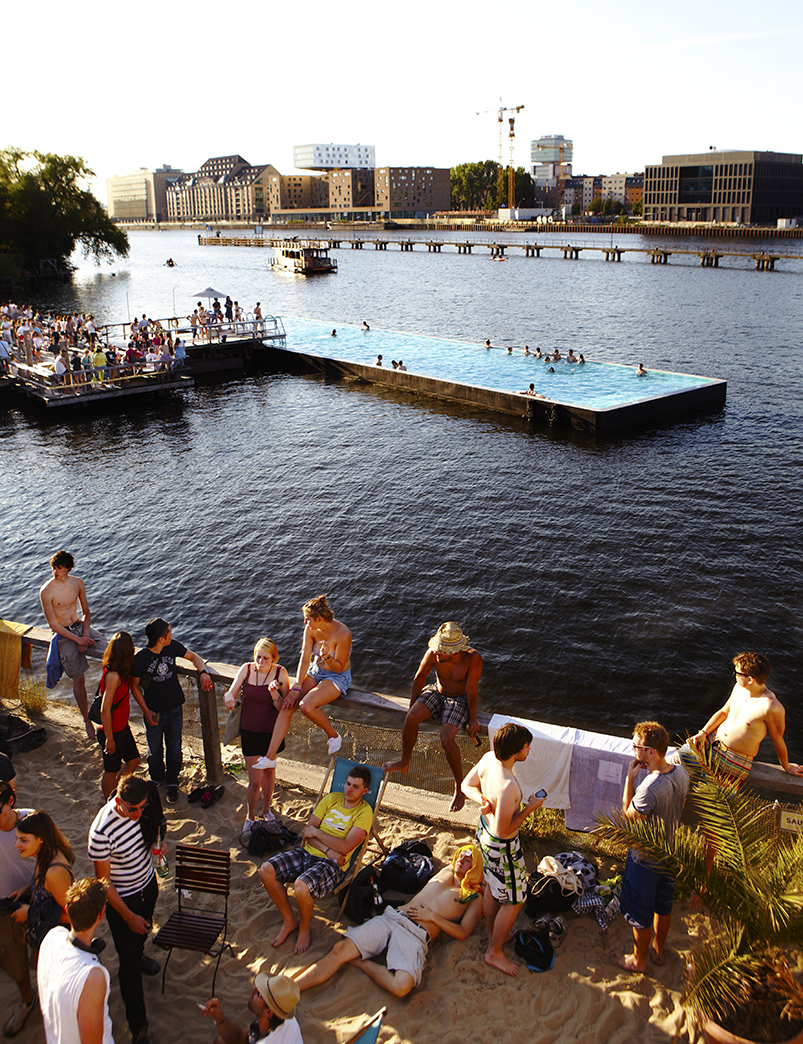
TTours
Guided tours are a great way for getting a quick Berlin primer and plenty of companies are happy to show you around on foot or by bus, boat or bike – and in English! If you’re short on time, let the sights whoosh by on a bus tour. Aside from traditional two- or three-hour spins, there are hop-on, hop-off tours as well as the handy bus lines 100 and 200 that let you see major landmarks for the price of a public transport ticket. Look for flyers in the hotel lobby or at tourist offices.
If you prefer sightseeing at a slower pace, join a walking tour. All run introductory spins around blockbuster and offbeat sights as well as themed tours (eg Third Reich, Cold War, Sachsenhausen, Potsdam).Walking tours are offered by the following companies.
Best Berlin Blogs
It’s no secret that Berlin is a fast-changing city, so it’s only natural that the food scene is also developing at lightning speed. Fortunately there are a number of passionate foodies keeping an eye on new openings and developments and generously sharing them on their (English-language) blogs. If you read German, also check out Mit Vergnügen (www.mitvergnuegen.com), Berlin Ick Liebe Dir (www.berlin-ick-liebe-dir.de) and GastroInferno (www.gastroinferno.com).
Berlin Food Stories (www.berlinfoodstories.com) Excellent up-to-the-minute site by a dedicated food lover who keeps tabs on new restaurants and visits each one several times before writing honest, mouth-watering reviews. Also runs food tours – see the website for dates.
Stil in Berlin (www.stilinberlin.de) One of the longest-running city blogs (since 2006), Mary Sherpe’s ‘baby’ keeps track of developments in food, fashion, style and art.
CeeCee (www.ceecee.cc) Stylish blog on what’s hot and what’s not across Berlin’s culinary and cultural spectrum.
I Heart Berlin (www.iheartberlin.de) Long-running blog spreads the love about cool places and upcoming events.
Eatler (www.eatler.de) Irreverent and opinionated blog on restaurant openings and closings and emerging trends.
Original Berlin Walks (![]() %030-301 9194; www.berlinwalks.de; adult/concession from €14/12)
%030-301 9194; www.berlinwalks.de; adult/concession from €14/12)
New Berlin Tours (www.newberlintours.com; tours adult/concession from €14/12; ![]() hfree tour 10am, 11am, noon, 2pm & 4pm)
hfree tour 10am, 11am, noon, 2pm & 4pm)
Brewer’s Berlin Tours (![]() %0177 388 1537; www.brewersberlintours.com; adult/concession €15/12)
%0177 388 1537; www.brewersberlintours.com; adult/concession €15/12)
Insider Tour Berlin (![]() %030-692 3149; www.insidertour.com; adult/concession €14/12)
%030-692 3149; www.insidertour.com; adult/concession €14/12)
Alternative Berlin Tours (![]() %0162 819 8264; www.alternativeberlin.com; tours €12-35).
%0162 819 8264; www.alternativeberlin.com; tours €12-35).
If you prefer to cover more ground, consider the following operators, who each offer a roster of similar tours.
Berlin on Bike (map Google map; ![]() %030-4373 9999; www.berlinonbike.de; Knaackstrasse 97, Kulturbrauerei, Court 4; tours incl bike adult/concession €24/20, bike rental per 24hr €10;
%030-4373 9999; www.berlinonbike.de; Knaackstrasse 97, Kulturbrauerei, Court 4; tours incl bike adult/concession €24/20, bike rental per 24hr €10; ![]() h8am-8pm mid-Mar–mid-Nov, 10am-4pm Mon-Sat mid-Nov–mid-Mar;
h8am-8pm mid-Mar–mid-Nov, 10am-4pm Mon-Sat mid-Nov–mid-Mar; ![]() jM1,
jM1, ![]() bEberswalder Strasse)
bEberswalder Strasse)
Fat Tire Tours Berlin (map Google map; ![]() %030-2404 7991; www.fattiretours.com/berlin; Panoramastrasse 1a; adult/concession/under 12 incl bicycle from €28/26/14;
%030-2404 7991; www.fattiretours.com/berlin; Panoramastrasse 1a; adult/concession/under 12 incl bicycle from €28/26/14; ![]() bAlexanderplatz,
bAlexanderplatz, ![]() bAlexanderplatz)
bAlexanderplatz)
In fine weather, the most leisurely way to see the city is from its canals or rivers aboard a boat cruise, such as those offered by the following companies.
Reederei Riedel (![]() %030-6796 1470; www.reederei-riedel.de; tours from €14;
%030-6796 1470; www.reederei-riedel.de; tours from €14; ![]() hMar-Oct)
hMar-Oct)
Stern und Kreisschiffahrt (![]() %030-536 3600; www.sternundkreis.de; tours from €15;
%030-536 3600; www.sternundkreis.de; tours from €15; ![]() hMar-Dec).
hMar-Dec).
There are also all sorts of fascinating niche tours, including a Bowie Walk with Berlin Music Tours (![]() %0172 424 2037; www.musictours-berlin.com; Bowie walk €19;
%0172 424 2037; www.musictours-berlin.com; Bowie walk €19; ![]() hnoon Sat & Sun Apr-Oct, 11.30am Nov-Mar) or a sustainable Berlin tour with Green Me (www.greenmeberlin.com; public tours per person €30-50, private tours on request)
hnoon Sat & Sun Apr-Oct, 11.30am Nov-Mar) or a sustainable Berlin tour with Green Me (www.greenmeberlin.com; public tours per person €30-50, private tours on request) ![]() S.
S.
7Shopping
Berlin is a great place to shop, and we’re definitely not talking malls and chains. The city’s appetite for the individual manifests in small neighbourhood boutiques and buzzing markets that are a pleasure to explore.
KaDeWeDepartment Store
(map Google map; ![]() %030-212 10; www.kadewe.de; Tauentzienstrasse 21-24;
%030-212 10; www.kadewe.de; Tauentzienstrasse 21-24; ![]() h10am-8pm Mon-Thu, to 9pm Fri, 9.30am-8pm Sat;
h10am-8pm Mon-Thu, to 9pm Fri, 9.30am-8pm Sat; ![]() bWittenbergplatz)
bWittenbergplatz)
Continental Europe’s largest department store has been going strong since 1907 and boasts an assortment so vast that a pirate-style campaign is the best way to plunder its bounty. If pushed for time, at least hurry up to the legendary 6th-floor gourmet-food hall. The name, by the way, stands for Kaufhaus des Westens (department store of the West).
LP12 Mall of BerlinMall
(map Google map; www.mallofberlin.de; Leipziger Platz 12; ![]() h10am-9pm Mon-Sat;
h10am-9pm Mon-Sat; ![]() W;
W; ![]() g200,
g200, ![]() bPotsdamer Platz,
bPotsdamer Platz, ![]() bPotsdamer Platz)
bPotsdamer Platz)
This sparkling retail quarter is tailor-made for black-belt mall rats. More than 270 shops vie for your shopping euros, including flagship stores by Karl Lagerfeld, Hugo Boss, Liebeskind, Marc Cain, Muji and other international high-end brands, alongside the usual high-street chains like Mango and H&M. Free mobile-phone recharge stations in the basement and on the 2nd floor.
Bikini BerlinMall
(map Google map; ![]() %030-5549 6455; www.bikiniberlin.de; Budapester Strasse 38-50;
%030-5549 6455; www.bikiniberlin.de; Budapester Strasse 38-50; ![]() hshops 10am-8pm Mon-Sat, bldg 9am-8.30pm Mon-Sat, noon-6pm Sun;
hshops 10am-8pm Mon-Sat, bldg 9am-8.30pm Mon-Sat, noon-6pm Sun; ![]() W;
W; ![]() g100, 200,
g100, 200, ![]() bZoologischer Garten,
bZoologischer Garten, ![]() bZoologischer Garten)
bZoologischer Garten)
Germany’s first concept mall opened in 2014 in a smoothly rehabilitated 1950s’ architectural icon nicknamed ‘Bikini’ because of its design: 200m-long upper and lower sections separated by an open floor, now chastely covered by a glass facade. Inside are three floors of urban indie boutiques, short-lease pop-up ‘boxes’ for up-and-comers, and an international street-food court.
FLEA MARKETS
Flea markets are like urban archaeology: you’ll need plenty of patience and luck when sifting through other people’s cast-offs, but oh, the thrill, when you finally unearth a piece of treasure! Berlin’s numerous hunting grounds set up on weekends (usually Sunday) year-round – rain or shine – and are also the purview of fledgling local fashion designers and jewellery makers. The most famous market is the weekly Flohmarkt am Mauerpark (map Google map; www.flohmarktimmauerpark.de; Bernauer Strasse 63-64; ![]() h9am-6pm Sun;
h9am-6pm Sun; ![]() jM1, M10, 12,
jM1, M10, 12, ![]() bEberswalder Strasse) in Prenzlauer Berg, which is easily combined with a visit to nearby Trödelmarkt Arkonaplatz (map Google map; www.troedelmarkt-arkonaplatz.de; Arkonaplatz;
bEberswalder Strasse) in Prenzlauer Berg, which is easily combined with a visit to nearby Trödelmarkt Arkonaplatz (map Google map; www.troedelmarkt-arkonaplatz.de; Arkonaplatz; ![]() h10am-4pm Sun;
h10am-4pm Sun; ![]() jM1, M10,
jM1, M10, ![]() bBernauer Strasse).
bBernauer Strasse).
5Eating
Berlin’s food scene is growing in leaps and bounds and maturing as beautifully as a fine Barolo. Sure, you can still get your fill of traditional German comfort staples, from sausage to roast pork knuckle, but it’s the influx of experimental chefs from around the globe that makes eating in the capital such a delicious and exciting experience.
5Mitte
Katz OrangeInternational€€
(map Google map; ![]() %030-983 208 430; www.katzorange.com; Bergstrasse 22; mains €17-24;
%030-983 208 430; www.katzorange.com; Bergstrasse 22; mains €17-24; ![]() h6-11pm;
h6-11pm; ![]() jM8,
jM8, ![]() bRosenthaler Platz)
bRosenthaler Platz) ![]() S
S
With its holistic farm-to-table menu, stylish country flair and top-notch cocktails, the ‘Orange Cat’ hits a gastro grand slam. It will have you purring for such favourites as Duroc pork that’s been slow-roasted for 12 hours (nicknamed ‘candy on bone’). The setting in a castle-like former brewery is stunning, especially in summer when the patio opens.
Ki-NovaInternational€€
(map Google map; ![]() %030-2546 4860; www.ki-nova.de; Potsdamer Strasse 2; mains €9-17;
%030-2546 4860; www.ki-nova.de; Potsdamer Strasse 2; mains €9-17; ![]() h11.30am-11pm Mon-Fri, 1-11pm Sat, 1-9pm Sun;
h11.30am-11pm Mon-Fri, 1-11pm Sat, 1-9pm Sun; ![]() W
W![]() v;
v; ![]() g200,
g200, ![]() bPotsdamer Platz,
bPotsdamer Platz, ![]() bPotsdamer Platz)
bPotsdamer Platz) ![]() S
S
The name of this lunchtime favourite hints at the concept: ‘ki’ is Japanese for energy and ‘nova’ Latin for new. ‘New energy’ in this case translates into health-focused yet comforting bites starring global and regional superfoods from kale to cranberries. The contempo interior radiates urban warmth with heavy plank tables, black tiled bar, movie stills and floor-to-ceiling windows.
Cookies CreamVegetarian€€€
(map Google map; ![]() %030-2749 2940; www.cookiescream.com; Behrenstrasse 55; mains €25, 3-/4-course menu €49/59;
%030-2749 2940; www.cookiescream.com; Behrenstrasse 55; mains €25, 3-/4-course menu €49/59; ![]() h6pm-midnight Tue-Sat;
h6pm-midnight Tue-Sat; ![]() v;
v; ![]() bFranzösische Strasse)
bFranzösische Strasse)
In 2017, this perennial local favourite became Berlin’s first flesh-free restaurant to enter the Michelin pantheon, on its 10th anniversary no less. Its industrial look and clandestine location are as unorthodox as the compositions of head chef Stephan Hentschel. The entrance is off the service alley of the Westin Grand Hotel (past the chandelier, ring the bell).
Pauly SaalGerman€€€
(map Google map; ![]() %030-3300 6070; www.paulysaal.com; Auguststrasse 11-13; 3-/4-course lunches €69/85, 7-course dinners €115;
%030-3300 6070; www.paulysaal.com; Auguststrasse 11-13; 3-/4-course lunches €69/85, 7-course dinners €115; ![]() hnoon-2pm & 6-9.30pm Tue-Sat, bar to 2.30am;
hnoon-2pm & 6-9.30pm Tue-Sat, bar to 2.30am; ![]() jM1,
jM1, ![]() bOranienburger Strasse,
bOranienburger Strasse, ![]() bOranienburger Tor)
bOranienburger Tor)
Since taking the helm at this Michelin-starred outpost, Arne Anker has given the cuisine a youthful and light edge while following the seasonal-regional credo. Only multicourse menus are served, even at lunch. The venue itself – in the edgy-art-decorated gym of a former Jewish girls’ school (Jüdische Mädchenschule; map; www.maedchenschule.org; Auguststrasse 11-13; ![]() hhours vary)
hhours vary) ![]() F in a Bauhaus building – is simply stunning.
F in a Bauhaus building – is simply stunning.
5Prenzlauer Berg
Konnopke’s ImbissGerman€
(map Google map; ![]() %030-442 7765; www.konnopke-imbiss.de; Schönhauser Allee 44a; sausages €1.60-2.90;
%030-442 7765; www.konnopke-imbiss.de; Schönhauser Allee 44a; sausages €1.60-2.90; ![]() h10am-8pm Mon-Fri, 11.30am-8pm Sat;
h10am-8pm Mon-Fri, 11.30am-8pm Sat; ![]() jM1, M10, M13,
jM1, M10, M13, ![]() bEberswalder Strasse)
bEberswalder Strasse)
Brave the inevitable queue at this famous sausage kitchen, ensconced in the same spot below the elevated U-Bahn tracks since 1930, but now equipped with a heated pavilion and an English menu. The ‘secret’ sauce topping is classic Currywurst and comes in a four-tier heat scale from mild to wild.
5Kreuzberg & Friedrichshain
BurgermeisterBurgers€
(map Google map; ![]() %030-2388 3840; www.burger-meister.de; Oberbaumstrasse 8; burgers €3.50-4.80;
%030-2388 3840; www.burger-meister.de; Oberbaumstrasse 8; burgers €3.50-4.80; ![]() h11am-3am Mon-Thu, 11am-4am Fri, noon-4am Sat, noon-3am Sun;
h11am-3am Mon-Thu, 11am-4am Fri, noon-4am Sat, noon-3am Sun; ![]() bSchlesisches Tor)
bSchlesisches Tor)
It’s green, ornate, a century old and…it used to be a toilet. Now it’s a burger joint beneath the elevated U-Bahn tracks. Get in line for the plump all-beef patties (try the Meisterburger with fried onions, bacon and barbecue sauce) tucked between a brioche bun and paired with thickly cut cheese fries. Fast-food heaven!
Cocolo RamenbarJapanese€
(map Google map; ![]() %030-9833 9073; www.kuchi.de; Paul-Lincke-Ufer 39-40; soups €9-12;
%030-9833 9073; www.kuchi.de; Paul-Lincke-Ufer 39-40; soups €9-12; ![]() hnoon-11pm Mon-Sat, 6pm-midnight Sun;
hnoon-11pm Mon-Sat, 6pm-midnight Sun; ![]() W;
W; ![]() bKottbusser Tor)
bKottbusser Tor)
For some of Berlin’s top Japanese soups, follow locals to this lantern-lit canal-side charmer, where homemade noodles, fresh vegetables and toppings from egg to wakame bathe in a richly flavoured pork broth. The heart-warming winter dish is also a nice good-weather nosh, best enjoyed on the terrace with canal views.
5Schöneberg
Cafe Einstein StammhausAustrian€€€
(map Google map; ![]() %030-2639 1917; www.cafeeinstein.com; Kurfürstenstrasse 58; breakfast €7-15, mains dinner €19-32;
%030-2639 1917; www.cafeeinstein.com; Kurfürstenstrasse 58; breakfast €7-15, mains dinner €19-32; ![]() h8am-midnight;
h8am-midnight; ![]() bNollendorfplatz)
bNollendorfplatz)
In the former home of silent-movie star Henny Porten, this Vienna-style cafe is the living room of moneyed, genteel types reading the morning paper over black coffee or tucking into Wiener Schnitzel at night. The ‘Einstein breakfast’ is a prime pick any time of day (served until 6pm). Marble tabletops, jumbo-sized mirrors and high stucco-trimmed ceilings add to the sophisticated vibe.
5Charlottenburg
BenedictBreakfast€€
(![]() %030-994 040 997; www.benedict-breakfast.de; Uhlandstrasse 49; breakfast €7.50-18;
%030-994 040 997; www.benedict-breakfast.de; Uhlandstrasse 49; breakfast €7.50-18; ![]() h24hr;
h24hr; ![]() W;
W; ![]() bSpichernstrasse)
bSpichernstrasse)
It’s 4am or 4pm and you’re in the mood for blueberry pancakes or eggs benedict? No problem. At this upbeat restaurant, breakfast – and only breakfast! – is served, no matter where the hands of the clock. Portions are as huge as the selection, which takes inspiration from around the world, from classic German spreads to American steak and eggs via North African shakshuka.
Good FriendsChinese€€
(map Google map; ![]() %030-313 2659; www.goodfriends-berlin.de; Kantstrasse 30; 2-course weekday lunch €7-7.70, dinner mains €8-21;
%030-313 2659; www.goodfriends-berlin.de; Kantstrasse 30; 2-course weekday lunch €7-7.70, dinner mains €8-21; ![]() hnoon-1am;
hnoon-1am; ![]() bSavignyplatz)
bSavignyplatz)
Good Friends is widely considered Berlin’s best Cantonese restaurant. The ducks dangling in the window are merely a nod to a menu long enough to confuse Confucius, including plenty of authentic homestyle dishes (on a separate menu). If steamed chicken feet prove too challenging, you can always fall back on sweet-and-sour pork or fried rice with shrimp.
Berlin Loves to Boogie
Since the 1990s, Berlin’s club culture has taken on near-mythical status and, to no small degree, contributed to the magnetism of the German capital. It has incubated trends and sounds, launched the careers of such internationally renowned DJs as Paul van Dyk, Ricardo Villalobos, Ellen Allien and Paul Kalkbrenner, and put Berlin firmly on the map of global music fans who turn night into day in the over 200 clubs in this curfew-free city.
What distinguishes the Berlin scene from other party capitals is a focus on independent, non-mainstream niche venues, run by owners or collectives with a creative rather than a corporate background. The shared goal is to promote a diverse, inclusive and progressive club culture rather than to maximise profit. This is also reflected in a door policy that strives to create a harmonious balance in terms of age, gender and attitude.
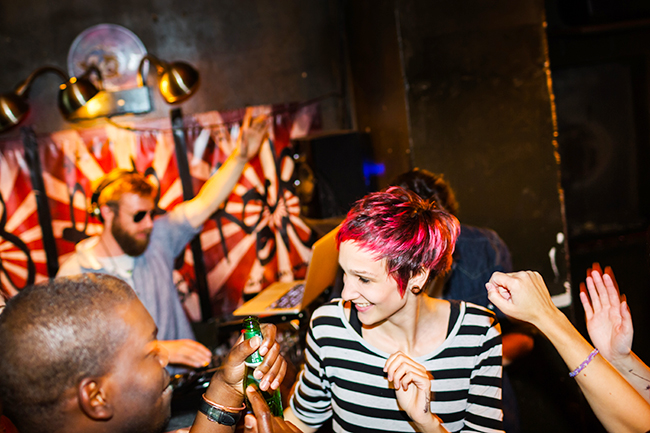
6Drinking & Nightlife
From cocktail lairs and concept bars, craft beer pubs to rooftop lounge, the next thirst parlour is usually within stumbling distance.
6Mitte
Rooftop TerraceBar
(map Google map; ![]() %030-460 6090; www.roccofortehotels.com; Behrenstrasse 37, Hotel de Rome;
%030-460 6090; www.roccofortehotels.com; Behrenstrasse 37, Hotel de Rome; ![]() h3-11pm Mon-Fri, from noon Sat & Sun May-Sep, weather permitting;
h3-11pm Mon-Fri, from noon Sat & Sun May-Sep, weather permitting; ![]() W;
W; ![]() g100, 200, TXL,
g100, 200, TXL, ![]() bHausvogteiplatz)
bHausvogteiplatz)
A hushed, refined ambience reigns at the rooftop bar of the exclusive Hotel de Rome, where you can keep an eye on the Fernsehturm (TV Tower), historic landmarks and the construction projects along Unter den Linden. It’s a chill spot for an afternoon coffee, a glass of homemade ginger lemonade or sunset cocktails with bar snacks.
Solar LoungeBar
(map Google map; ![]() %0163 765 2700; www.solar-berlin.de; Stresemannstrasse 76;
%0163 765 2700; www.solar-berlin.de; Stresemannstrasse 76; ![]() h6pm-2am Sun-Thu, to 3am Fri & Sat;
h6pm-2am Sun-Thu, to 3am Fri & Sat; ![]() bAnhalter Bahnhof)
bAnhalter Bahnhof)
Watch the city light up from this 17th-floor glass-walled sky lounge above a posh restaurant. With its dim lighting, soft black leather couches and breathtaking panorama, it’s a great spot for sunset drinks or a date. Getting there aboard an exterior glass lift is half the fun. The entrance is behind the Pit Stop auto shop.
Café am Neuen SeeBeer Garden
(map Google map; ![]() %030-254 4930; www.cafeamneuensee.de; Lichtensteinallee 2;
%030-254 4930; www.cafeamneuensee.de; Lichtensteinallee 2; ![]() hrestaurant 9am-11pm, beer garden noon-late Mon-Fri, 11am-late Sat & Sun;
hrestaurant 9am-11pm, beer garden noon-late Mon-Fri, 11am-late Sat & Sun; ![]() c;
c; ![]() g200,
g200, ![]() bZoologischer Garten,
bZoologischer Garten, ![]() bZoologischer Garten, Tiergarten)
bZoologischer Garten, Tiergarten)
Next to an idyllic lake in Tiergarten, this restaurant gets jammed year-round for its sumptuous breakfast and seasonal fare, but it really comes into its own during beer garden season. Enjoy a microvacation over a cold one and a pretzel or pizza, then take your sweetie for a spin in a rowing boat. Children’s playground, too.
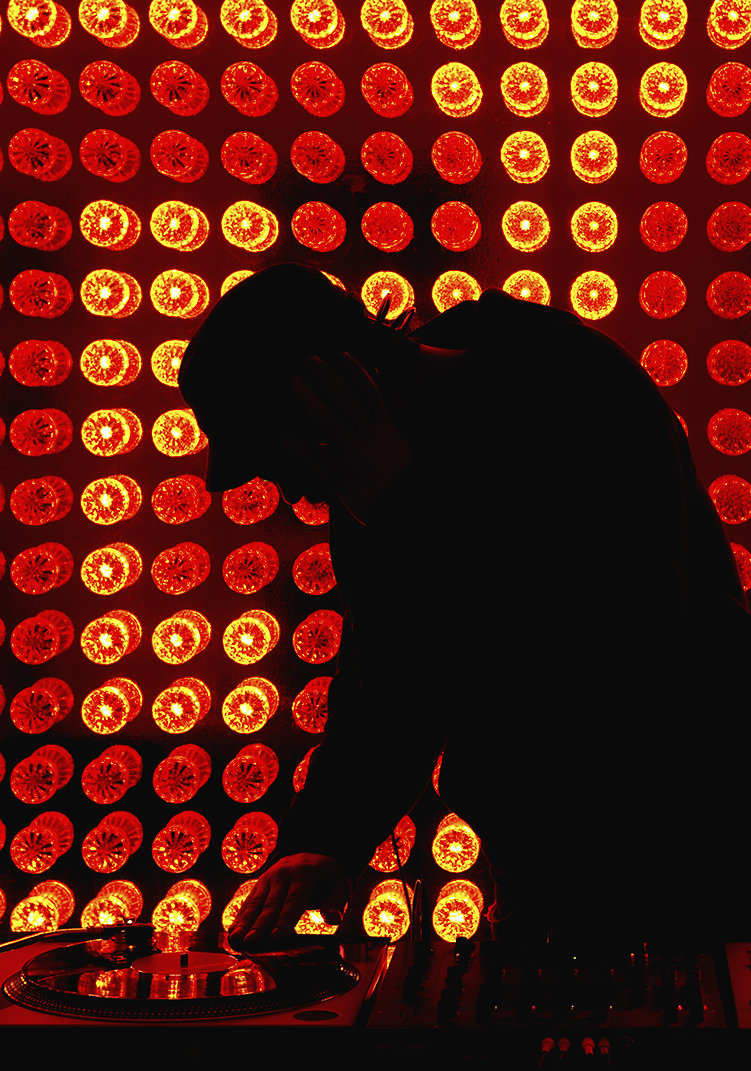
6Prenzlauer Berg & Friedrichshein
Berghain/Panorama BarClub
(map Google map; www.berghain.de; Am Wriezener Bahnhof; ![]() hFri-Mon;
hFri-Mon; ![]() bOstbahnhof)
bOstbahnhof)
Only world-class DJs heat up this hedonistic bass-junkie hellhole, found inside a labyrinthine ex-powerplant. Hard-edged minimal techno dominates the ex-turbine hall (Berghain) while house dominates at Panorama Bar, one floor up. Long lines, strict door, no cameras. Check the website for midweek concerts and record-release parties at the main venue and the adjacent Kantine am Berghain (map Google map; admission varies; ![]() hhours vary).
hhours vary).
Prater GartenBeer Garden
(map Google map; ![]() %030-448 5688; www.pratergarten.de; Kastanienallee 7-9; snacks €2.50-7.50;
%030-448 5688; www.pratergarten.de; Kastanienallee 7-9; snacks €2.50-7.50; ![]() hnoon-late Apr-Sep, weather permitting;
hnoon-late Apr-Sep, weather permitting; ![]() c;
c; ![]() jM1, 12,
jM1, 12, ![]() bEberswalder Strasse)
bEberswalder Strasse)
Berlin’s oldest beer garden has seen beer-soaked days and nights since 1837. It is still a charismatic spot for guzzling a custom-brewed Prater pilsner (self-service) beneath the ancient chestnut trees. Kids can romp around the small play area.
Weinerei ForumWine Bar
(map Google map; ![]() %030-440 6983; www.weinerei.com; Fehrbelliner Strasse 57;
%030-440 6983; www.weinerei.com; Fehrbelliner Strasse 57; ![]() h10am-midnight;
h10am-midnight; ![]() W;
W; ![]() jM1,
jM1, ![]() bRosenthaler Platz)
bRosenthaler Platz)
After 8pm, this living-room-style cafe turns into a wine bar that works on the honour principle: you ‘rent’ a wine glass for €2, then help yourself to as much vino as you like and at the end decide what you want to pay. Please be fair to keep this fantastic system going.
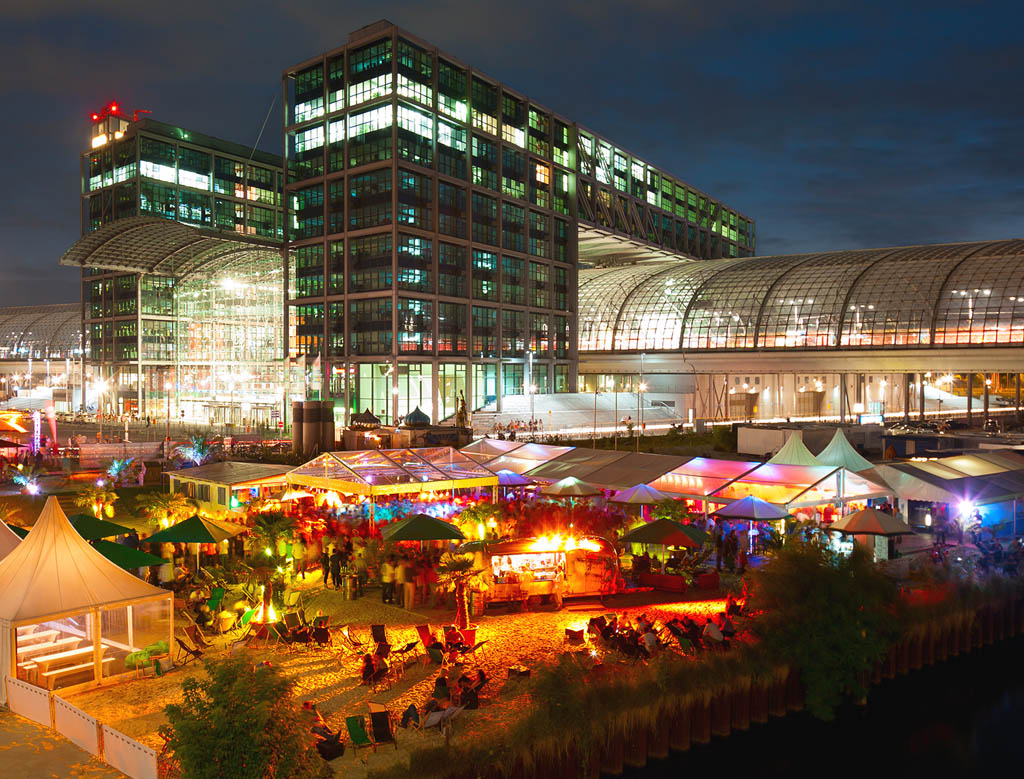
6Kreuzberg & Neukölln
GriessmühleClub
(www.griessmuehle.de; Sonnenallee 221; ![]() hclub from 10pm Fri & Sat;
hclub from 10pm Fri & Sat; ![]() bSonnenallee)
bSonnenallee)
Hugging an idyllic canal in Neukölln, Griessmühle is a sprawling indoor–outdoor space with a funky garden strewn with tree houses, Trabis (GDR-era cars) and flower beds. The project by the ZMF artist collective woos attitude-free electro lovers with an events roster that includes not only parties and concerts but also a monthly flea market, movie nights and ping-pong parties.
KlunkerkranichBar
(www.klunkerkranich.de; Karl-Marx-Strasse 66; ![]() h4pm-2am;
h4pm-2am; ![]() W;
W; ![]() bRathaus Neukölln)
bRathaus Neukölln)
In the warmer months, vibes, views and sounds are the ammo of this club-garden-bar combo on the rooftop parking deck of the Neukölln Arcaden shopping mall. It’s a great place for day-to-night drinking and chilling to local DJs or bands. Sustenance is provided. Check the website – these folks come up with new ideas all the time (gardening workshops anyone?).
6Schöneberg & Charlottenburg
Monkey BarBar
(map Google map; ![]() %030-120 221 210; www.monkeybarberlin.de; Budapester Strasse 40;
%030-120 221 210; www.monkeybarberlin.de; Budapester Strasse 40; ![]() hnoon-2am;
hnoon-2am; ![]() W;
W; ![]() g100, 200,
g100, 200, ![]() bZoologischer Garten,
bZoologischer Garten, ![]() bZoologischer Garten)
bZoologischer Garten)
On the 10th floor of the 25hours Hotel Bikini Berlin, this mainstream-hip ‘urban jungle’ delivers fabulous views of the city and Zoo Berlin while the menu gives prominent nods to tiki concoctions (great Mai Tai!) and gin-based cocktail sorcery. Come early for chilled sundowners on the sweeping terrace. Different DJs spin nightly Friday to Sunday, from 4pm.
Möve im FelsenkellerPub
(![]() %030-781 3447; Akazienstrasse 2;
%030-781 3447; Akazienstrasse 2; ![]() h4pm-midnight Mon-Sat;
h4pm-midnight Mon-Sat; ![]() bEisenacher Strasse)
bEisenacher Strasse)
An artist hang-out since the 1920s, this woodsy Old Berlin pub is where Jeffrey Eugenides penned his bestseller Middlesex (upstairs, at the round table in the corner). A stuffed seagull dangles from the ceiling of the storied haunt where you can choose from six beers on tap.
HafenBar
(map; ![]() %030-211 4118; www.hafen-berlin.de; Motzstrasse 19;
%030-211 4118; www.hafen-berlin.de; Motzstrasse 19; ![]() hfrom 7pm;
hfrom 7pm; ![]() bNollendorfplatz)
bNollendorfplatz)
3Entertainment
Berlin’s cultural scene is lively, edgy and the richest and most varied in the German-speaking world. With three state-supported opera houses, five major orchestras – including the world-class Berliner Philharmoniker (map Google map; ![]() %tickets 030-2548 8999; www.berliner-philharmoniker.de; Herbert-von-Karajan-Strasse 1; tickets €21-290;
%tickets 030-2548 8999; www.berliner-philharmoniker.de; Herbert-von-Karajan-Strasse 1; tickets €21-290; ![]() gM29, M48, M85, 200,
gM29, M48, M85, 200, ![]() bPotsdamer Platz,
bPotsdamer Platz, ![]() bPotsdamer Platz) – scores of theatres, cinemas, cabarets and concert venues, Berlin is replete with entertainment options.
bPotsdamer Platz) – scores of theatres, cinemas, cabarets and concert venues, Berlin is replete with entertainment options.
8INFORMATION
Visit Berlin (www.visitberlin.de), the Berlin tourist board, operates five walk-in offices, info desks at the airports, and a call centre (![]() %030-2500 2333;
%030-2500 2333; ![]() h9am-6pm Mon-Fri) whose multilingual staff field general questions and make hotel and ticket bookings.
h9am-6pm Mon-Fri) whose multilingual staff field general questions and make hotel and ticket bookings.
Alexanderplatz (![]() %030-250 025; lobby Park Inn, Alexanderplatz 7;
%030-250 025; lobby Park Inn, Alexanderplatz 7; ![]() h7am-9pm Mon-Sat, 8am-6pm Sun;
h7am-9pm Mon-Sat, 8am-6pm Sun; ![]() g100, 200, TXL,
g100, 200, TXL, ![]() bAlexanderplatz,
bAlexanderplatz, ![]() bAlexanderplatz)
bAlexanderplatz)
Brandenburger Tor (map Google map; ![]() %030-250 023; Pariser Platz, Brandenburger Tor, south wing;
%030-250 023; Pariser Platz, Brandenburger Tor, south wing; ![]() h9.30am-7pm Apr-Oct, to 6pm Nov-Mar;
h9.30am-7pm Apr-Oct, to 6pm Nov-Mar; ![]() bBrandenburger Tor,
bBrandenburger Tor, ![]() bBrandenburger Tor)
bBrandenburger Tor)
Central Bus Station (ZOB) (Masurenallee 4-6; ![]() h8am-8pm Mon, Fri & Sat, to 4pm Tue-Thu & Sun;
h8am-8pm Mon, Fri & Sat, to 4pm Tue-Thu & Sun; ![]() bMesse Nord/ICC)
bMesse Nord/ICC)
Europa-Center (map; ![]() %030-2500 2333; Tauentzienstrasse 9, Europa-Center, ground fl;
%030-2500 2333; Tauentzienstrasse 9, Europa-Center, ground fl; ![]() h10am-8pm Mon-Sat;
h10am-8pm Mon-Sat; ![]() g100, 200,
g100, 200, ![]() bKurfürstendamm, Zoologischer Garten,
bKurfürstendamm, Zoologischer Garten, ![]() bZoologischer Garten)
bZoologischer Garten)
Hauptbahnhof (![]() %030-250 025; Hauptbahnhof, Europaplatz entrance, ground fl;
%030-250 025; Hauptbahnhof, Europaplatz entrance, ground fl; ![]() h8am-10pm;
h8am-10pm; ![]() bHauptbahnhof,
bHauptbahnhof, ![]() dHauptbahnhof)
dHauptbahnhof)
8GETTING THERE & AWAY
AIR
Until completion of the Berlin Brandenburg Airport (due in 2020, currently 8 years behind schedule), flights continue to land at Berlin’s Tegel Airport (TXL; www.berlin-airport.de; ![]() gFlughafen Tegel), about 8km northwest of the city centre, and at Schönefeld Airport (SXF; www.berlin-airport.de;
gFlughafen Tegel), about 8km northwest of the city centre, and at Schönefeld Airport (SXF; www.berlin-airport.de; ![]() dAirport-Express, RE7 & RB14,
dAirport-Express, RE7 & RB14, ![]() bS9, S45), about 24km southeast.
bS9, S45), about 24km southeast.
BUS
Travelling to Berlin by coach has become easy, affordable and popular. Buses are comfortable, clean and air-conditioned; some offer free on-board wi-fi and sell snacks and soft drinks.
Having gobbled up much of its competitors, Flixbus (www.flixbus.de) is now the main operator with only Eurolines (www.eurolines.de) holding its own, at least for now. A handy intercity bus search engine is www.busradar.com.
TRAIN
Berlin is well connected by Deutsche Bahn (![]() %01806 99 66 33; www.bahn.de) rail services throughout Germany and to popular European destinations, including Prague, Warsaw and Amsterdam.
%01806 99 66 33; www.bahn.de) rail services throughout Germany and to popular European destinations, including Prague, Warsaw and Amsterdam.
While all long-distance trains converge at the Hauptbahnhof, some also stop at other stations such as Spandau, Ostbahnhof, Gesundbrunnen and Südkreuz.
Europe’s biggest long-distance coach company Flixbus has also launched Flixtrain (www.flixtrain.de). Since August 2017, its mamba-green carriages trundle from Berlin to Stuttgart with stops in Frankfurt and Heidelberg, among others. Prices are generally much lower than Deutsche Bahn’s. Trains depart from many Berlin train stations, including Haupbahnhof, Ostbahnhof and Bahnhof Zoo.
8GETTING AROUND
TO/FROM THE AIRPORT
TEGEL
TXL express bus to Alexanderplatz (40 minutes) and bus X9 for CityWest (eg Zoo station, 20 minutes), €2.80; taxi €25.
SCHöNEFELD
Airport-Express trains (RB14 or RE7) to central Berlin twice hourly (30 minutes), and S9 trains every 20 minutes for Friedrichshain and Prenzlauer Berg, €3.40; taxi to city centre €45 to €50.
PUBLIC TRANSPORT
Berlin’s comprehensive public transport system is administered by BVG and consists of the U-Bahn (subway), the S-Bahn (light rail), buses and trams. For full information and a handy journey planner, go to www.bvg.de.
For most rides you need an AB ticket (€2.80) valid for two hours with transfers permitted in the direction of travel. If you’re taking more than two trips per day, a Tageskarte (day pass) is good value (€7).
U-BAHN
Most efficient way to travel; operates 4am to 12.30am and all night Friday, Saturday and public holidays. From Sunday to Thursday, half-hourly night buses take over in the interim.
S-BAHN
Less frequent than U-Bahn trains but with fewer stops, and thus useful for longer distances. Same operating hours as the U-Bahn.
BUS & TRAM
Buses are slow but useful for sightseeing on the cheap and run frequently 4.30am to 12.30am; half-hourly night buses in the interim. MetroBuses (designated eg M1, M19) operate 24/7.
Trams operate only in the eastern districts; MetroTrams (designated eg M1, M2) run 24/7.
TAXI
Can be hailed or ordered by phone (030-20 20 20) or smartphone app. Taxi ranks are ubiquitous in the centre.
iWhere to Stay
Berlin offers the gamut of places to rest your weary head: from a former bank, boat or factory, in the home of a silent-movie diva or in a ‘flying bed’. Too off-beat? Every major international chain has a showcase property here.
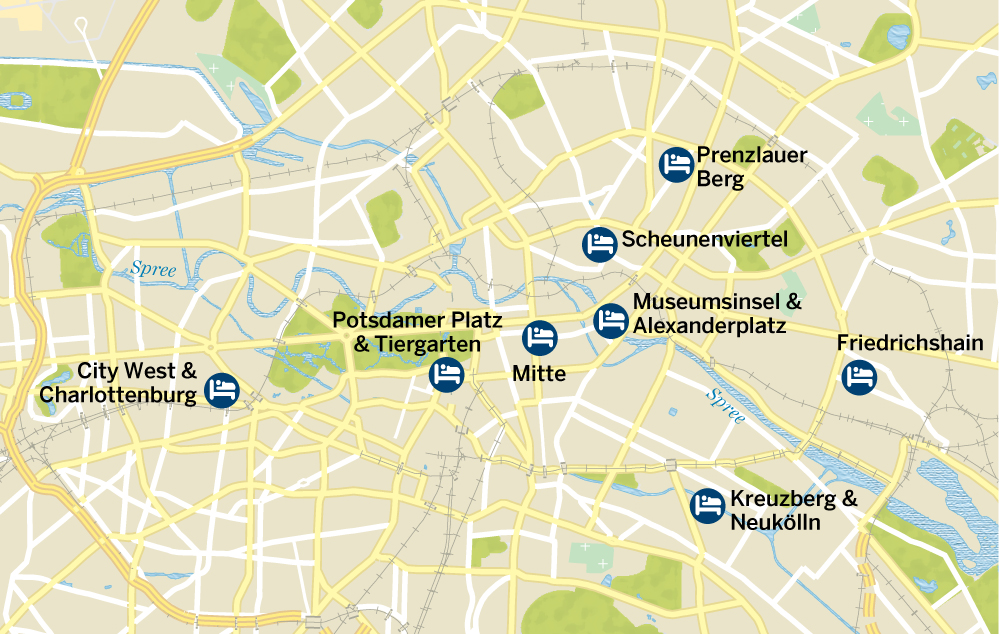
| Neighbourhood | Atmosphere |
|---|---|
| Mitte | Close to major sights; great transport links; top hotels and restaurants; can be touristy and expensive. |
| Museumsinsel & Alexanderplatz | Supercentral sightseeing quarter; easy transport access; mainstream shopping; large and new hotels; no nightlife. |
| Potsdamer Platz & Tiergarten | Cutting-edge architecture; high-end hotels; top museums; next to huge Tiergarten city park; limited eating options and no nightlife. |
| Scheunenviertel | Hipster; trendy, historic, central; boutique hotels; indie shopping; strong cafe scene; street art; can be pricey and busy. |
| City West & Charlottenburg | Great shopping; stylish bars and quality restaurants; good-value lodging; historic B&Bs; far from key sights and happening nightlife. |
| Kreuzberg & Neukölln | Vibrant arty, underground and multicultural party quarter; best for bar-hopping and clubbing; foodie scene; street art; gritty, noisy and busy; away from main sights. |
| Friedrichshain | Student and family quarter; nightlife; superb Cold War–era sights; transport difficult in some areas and limited sleeping options. |
| Prenzlauer Berg | Clean residential area; lively cafe and restaurant scene; indie boutiques; limited late-night action; few essential sights. |

